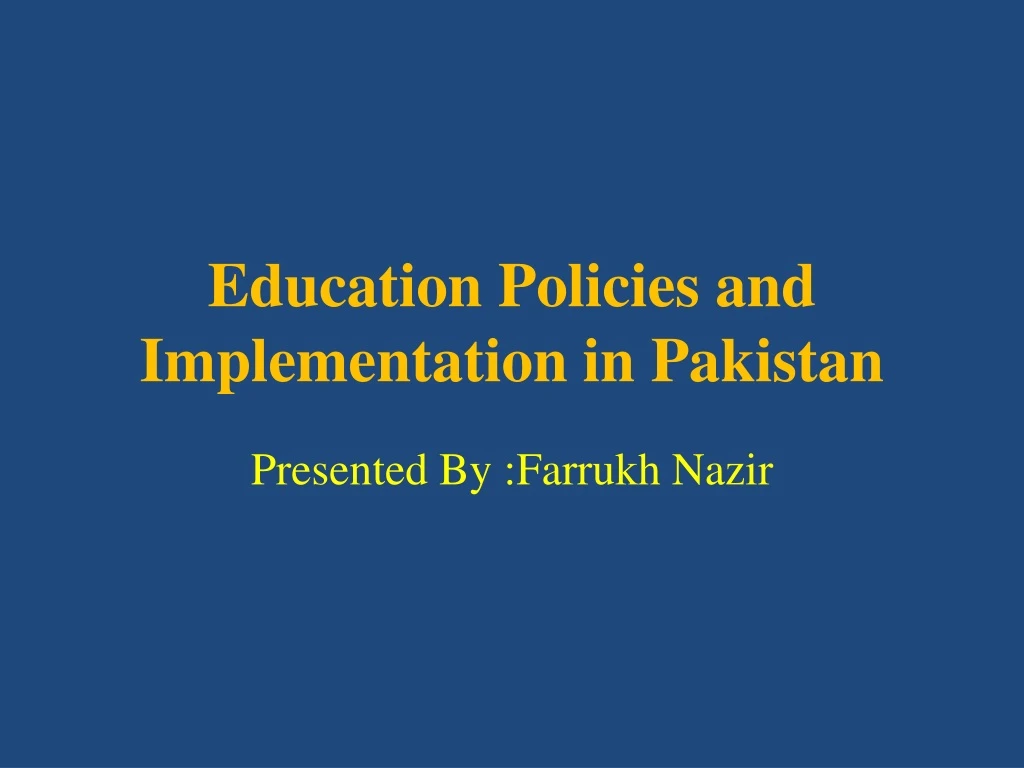

Education Policies and Implementation in Pakistan
Sep 23, 2010
610 likes | 2.28k Views
Education Policies and Implementation in Pakistan. Presented By :Farrukh Nazir. Education policy.
Share Presentation
- education policy
- education committee
- adult education
- national education policy
- education policy 1972 80

Presentation Transcript
Education Policies and Implementation in Pakistan Presented By :Farrukh Nazir
Education policy • Education policy is the principles and government policy-making in educational sphere, as well as the collection of laws and rules that govern the operation of education systems.(wikipedia2013). • Education occurs in many forms for many purposes through many institutions. • Examples include early childhood education, kindergarten through to 12th grade, two and four year colleges or universities, graduate and professional education, adult education and job training. • Therefore, education policy can directly affect the education people engage in at all ages.
Goals of Education Policy 1. Improve the academic success of all students by strengthening standards-based reforms, including assessments and accountability measures. 2. Establish and maintain a statewide education finance system based upon principles of adequacy, equity, accountability and predictability. 3. Build effective educational capacity to support learning by all students, with special emphasis on the need to ensure a qualified teacher in every classroom at all times.
Goals of Education Policy 4. Ensure that all every school shall have school leaders who will promote and support high achievement for all students through effective instructional leadership, school management and governance. 5. Enact state policies that shall ensure that every young child in the state shall have access to high-quality early education programs including pre-school and full-day kindergarten. 6. Ensure that all citizens of all ages shall have practical financial and physical access to a rich range of post-secondary educational opportunities.
Education in Pakistan at the time of Independence • Pakistan achieved independence from over a century of British colonial rule in August 1947. • The regions comprising Pakistan were relatively backward in all respects, including in education.
Education Policies in Pakistan • National Education Conference: 1947 • The New Education Policy: 1970 • The Education Policy: 1972-80 • National Education Policy and Implementation Programme: 1979 • National Education Policy: 1992 • National Education Policy: 1998-2010
National Education Conference: 1947 • First attempts in the field of education and literacy was the national education conference in1947. • The Quaid-e-Azam, in his message to the conferences said: "The importance of education and the type of education cannot be over-emphasized there is no doubt that the future of our state will and must greatly depend upon the type of education we give to our children, and the way in which we bring them up as future citizens of Pakistan ... we should not forget that we have to compete with the world which is moving very fast in this direction."
National Education Conference: 1947 • The first National Education Conference was held in 1947. • The Chairman the Conference set up following Sub-Committees to come up with the recommending guidelines in each sector: a) Scientific Research and Technical Education Committee b) Adult Education Committee c) University Education Committee d) Primary and Secondary Education Committee e) University Education and Primary and Secondary Education f) Women’s Education Committee
National Education Conference: 1947 g) Committee for scheduled caste and backward classes education. h) Cultural Relations Committee. i) Joint meeting of the committees on the university. education, scientific research and technical education and cultural contacts. j) Joint meeting of the committees on University Education, Women’s Education and Primary and Secondary Education.(Education in Pakistan UNESCO 2007) • The reports of various committees were submitted for finalization on 29th November, 1947. • The report was shared in November, 1947.
Main issues focused in the deliberation of the conference • Committee dwelt on the problems and constraints facing the task and identified issues of training adult school teachers, teaching materials and literature for adult schools, instruction methodologies, etc. • Committee cautioned against attempting to draw up a code or prescribe uniform methods applicable to the country as a whole and, instead, called for a committee of experts report on questions of teaching technique and results of experimentation. • Committee also advised against drawing any rigid distinction between adult education in the strict sense and technical, commercial or art instruction and suggested that adult students may be provided literacy through subjects of a vocational character.
Recommendations • The report recommended the following stages for the execution of a programme of adult education. • The first 5 years were to be devoted to planning, recruitment of teachers and training. • In the sixth year, about 500,000 persons were to be made literate with an annual increase of 300,000 thereafter. • Committee acknowledged that illiteracy was not confined to the rural areas and a large proportion of the urban population was also illiterate.
Recommendations • Committee called on all government departments and all employers and trade unions to ensure that their employees, workers, and members are literate. • The question of levying a tax on those employers who do not make adequate provision for the education of their employees was also presented for consideration. • the possibility of making a period of social service obligatory on all university students and • The use of mechanical aids to learning, such as radio, cinema, the gramophone, and magic lantern. • The report was shared in November, 1947.
Implementation • This policy could not be implemented properly due to increased number of immigrants and other administrative problems of new born country. • So more or less British colonial system was continued.
The Ne w Education Policy: 1970 • The President announced that Government would lay greater emphasis on the social sectors and would attach high priority to the educational problem. • A set of proposals of a new education policy were formulated. • In the light of public comments, the original proposals were reviewed. • The Cabinet considered the revised proposals and appointed a committee to examine them in detail. • The revised proposals were reviewed by the committee of the Cabinet in the light of implications of the announcement by the President in his address to the nation on November 28, 1969. • The new Education Policy was finally adopted by the Cabinet on March 26, 1970.
Salient features This policy has following salient features: • Emphasis on ideological orientation. • Emphasis on science and technology education. • Decentralization of educational administration. • The Policy aimed at free and universal enrolment up to Class V by 1980, with particular stress on girl’s education. • Policy also identified that there were about 100 million illiterates in Pakistan of whom 90 percent are concentrated in the rural areas. • Policy innovated further to aim at covering 5 million adults and school leavers by 1975 through requiring all employers, including government, to provide work-oriented basic education to all of their employees. • Establishment of a National Education Corps.(Kaiser Bengali 1999)
Implementation • The policy was never implemented on account of the war with India, secession of East Pakistan, and the collapse of the military government. Country's literacy status: • At the time of the emergence of the "new" Pakistan in 1972, the country's literacy status was as follows: • Overall literacy rate was 21.7 percent, urban literacy was 41.5 percent, rural literacy was 14.3 percent, • Male literacy was 30.2 percent, and female literacy was 11.6 percent. Rural female literacy was 4.7 percent.(Kaiser Bengali 1999)
The Education Policy:1972-1980 The 1972-1980 Education Policy was drafted in a somewhat matter of fact tone and refrained from philosophical pronouncements. Objectives: • Policy aimed at “eradicating illiteracy within the shortest possible time through universalization of elementary education and a massive adult education programme. • Equalizing access to education through provision of special facilities for women. • Under-privileged groups and mentally-retarded and physically-handicapped children and adults in all areas in general and the backward areas in particular will give preference.
The Education Policy: 1972-80 • Policy declared that education will be made free and universal up to class x for all children throughout the country in both government and privately-managed schools. • Private schools will be suitably supported for the loss of fees incurred by them. • The earlier objective of compulsory education was discarded. • The Policy proposed to construct 61,000 additional class-rooms for primary classes, train 150,000 teachers, and recruit an additional 75,000 teachers through the National Literacy Corps.
The Education Policy: 1972-80 • The 1972 Policy identified 40 million adult illiterates in the country and declared that a massive literacy program will be undertaken in every town. • literacy centers will be established all over the country in schools, factories, farms, union council halls and other community places. • A target of establishing 276,000 literacy centers to educate 11 million persons was fixed for the period 1972-80. • The new Education Policy was finally adopted by the Cabinet on March 26, 1970.
Implementation • This policy was a good approach towards betterment, but has many drawbacks due to which it cannot be achieved thoroughly e.g. universal basic education, shift towards agro technical studies etc.
National Education Policy and Implementation Programme: 1979 Salient features: • The 1979 Education Policy was presented one year after the launching of the Fifth Five Year Plan, with a change of target dates. • The Fifth Plan proposed to enroll all boys of Class I age by 1982-83 and achieve universal enrolment for the entire age group (5-9) by 1986-87 • the 1979 Policy proposed to achieve the same by 1987 and 1992, respectively.. • The Policy was presented as “the first in recognizing the great potentials of our indigenous institutions and patronizing them for bringing about greater educational development”.
National Education Policy and Implementation Programme: 1979 • The Policy aimed at providing a minimum acceptable level of functional literacy and fundamental education to all citizens of the country particularly the young, irrespective of their faith, caste, and creed in order to enable them to participate productively in the total national effort. • The Policy also provided for an elaborate adult education programme. • The programme proposed to set up 10,000 adult literacy centers to be sponsored by the Ministry of Education, Pakistan Television Centers, IRDP markazes, Allama Iqbal Open University study centers, and social welfare centers.
National Education Policy and Implementation Programme: 1979 • The possibility of a student volunteer corps, comprising bachelors and master’s level students was also envisaged. • It was claimed that the programme will raise literacy levels from 24 percent to 35 percent by 1983 and attain 100 percent literacy by 2010.” • The 1981 population census results regarding the literacy status of the country constituted an evaluation, without comment, of the educational policies and plans over the three decades since independence in 1947. • The Policy was announced in February 1979.
National Aims of Education The policy presented a 9-point statement of “National Aims of Education" and a 12-point implementation strategy. The implementation programme was ambitious and proposed to: 1.Achieve universal class I enrolment of boys by 1987 and of girls by 1992. 2. Eliminate wastage to achieve 60 percent retention rate by 1983 and 100 percent thereafter 3. Reconstruct/improve 17,000 existing primary schools 4. Open 13,000 new primary schools, mainly in rural areas 5. Establish 5000 mosque schools for boys 6. Provide equipment to 12,000 existing schools
National Aims of Education 7. Supply text-books to all students at the primary level . 8. Supply at least one teaching kit to all existing and new schools 9. Experiment with different mixes of inputs to determine direction for large scale investment in primary education 10. Carry out a nation-wide school mapping exercise to evolve a process of school location planning 11. Undertake a nation-wide survey to determine repair needs of existing primary schools and launch a programme of repairs. 12. In addition to the 5000 Mosque schools for boys, the Programme also envisaged opening 5000 Mohalla schools for girls, and 1000 Village Workshop schools to impart training in “mother trades like carpentry, masonry and agriculture” and focus on “appropriate skill development linked with community needs”.
Implementation • This policy was not implemented properly and failed due to lack of planning and financial resources.
National Education Policy: 1992 • The socio-political milieu, among other factors, promoted to reshuffle the priorities, restate the policy, revise the strategy, and re-examine the fabric of education in Pakistan. • A series of educational conferences were held in the Provinces which were attended by a large number of educationists and educational administrators from the primary to the university level. • A National Conference was held at Islamabad in April, 1991 under the chairmanship of the Federal Education Minister. • A cross section of the society comprising scholars, writers,newspaper editors, scientists, teachers and Lawyers participated and discussed proposals for preparing the dynamics of the Education Policy.
National Education Policy: 1992 Key elements of the policy are: 1. Opening non-formal education to non-governmental organizations; 2. Achieving 100% literacy in selected districts; 3. Setting up model schools (male and female) in rural areas; 4. Introducing compulsory social service for students; 5. Using general schools as technical schools in the evening shift to capture the drop-outs of general education.
Concerned Issues • The participation rates at various levels of education are low. • The progress in the direction of universalization of primary education is far from satisfactory. • At primary level, the drop-out rates are in the vicinity of 50 per cent. • The women participation in education is minimal. • The policy on the medium of instruction has vacillated. • The quality of public instruction continues to deteriorate; the system has not responded to the inputs made.
Concerned Issues • The curricula, apart from being overloaded, have not kept pace with the advancement of knowledge. So are the textbooks which do not promote self-learning.” • Pakistan has one of the lowest literacy rates in the region currently estimated at about 34 per cent. • The literacy ratios have been further aggravated because of the absence of meaningful literacy programmes and a rapid population growth. • Consequently, all children who are not enrolled, and those who drop-out early, join the multitude of illiterates every year. • Ignoring the existence of LAMEC, it also bemoaned that: “At present there is no national programme of adult literacy.
Recommendations • As it primary objective, the Policy stated thus: “Basic education for all shall be pursued not merely as a sect oral target, but as an integral part of human development plan. • The ultimate aim is to eliminate disparity , the drama of under-development • The raising of the collective ego of the nation through a facilitated, efficient and effective educational system remains the primary goal of the policy. • It hoped that the measures will lift the system to a respectable level of excellence during its growth in the next 10 years. • it proposed to ensure 100 per cent participation of children in education at the primary level by the year 2002, and to eradicate illiteracy through formal and non-formal methods.
Recommendations • It also proposed to “increase the literacy rate to 70 per cent by the year 2002. • Primary education was to be made compulsory. • A major shift in strategy also occurred, in the sense that it proposed to shift most of the adult education programmes to non-governmental organizations, to be supported through ‘incentive’ grants from provincial and federal Education foundations. • The Policy proposed what it called innovations as “a tool for quantum jump towards excellence.” • The Policy was announced in December 1992.
Implementation • This policy could not be implemented due to change in political scenario of country
Educational policy of Pakistan 1998 to 2010 Introduction: According to the constitution of 1973, article 25 1. All citizens are equal before law and are entitled to equal protection of law. 2. There shall be no discrimination on the basis of sex alone. 3. Nothing in this constitution shall present the state from making any special provision for the protection of women and children.
Salient Features of National Education Policy 1998 -2010 Aims and objectives of Education and Islamic Education: • Education and training should enable the citizens of Pakistan to lead their lives according to the teachings of Islam as laid down in the Qur'an and Sunnah and to educate and train them as a true practicing Muslim. • To evolve an integrated system of national education by bringing Deeni Madaris and modern schools closer to each stream in curriculum and the contents of education. • Nazira Qur'an will be introduced as a compulsory component from grade I-VIII • While at secondary level translation of the selected verses from the Holy Qur'an will be offered.
Salient Features of National Education Policy 1998-2010 Literacy and Non-Formal Education: • The current literacy rate of about 39% will be raised to 55% during the first five years of the policy and 70% by the year 2010 • Functional literacy and income generation skills will be provided to rural women of 15 to 25 age. • Group and basic educational facilities will be provided to working children. • Functional literacy will be imparted to adolescents (10-14) who missed out the chance of primary education. • The existing disparities in basic education will be reduced to half by year 2010.
Salient Features of National Education Policy 1998-2010 Elementary Education: • About 90% of the children in the age group (5-9) will be enrolled in schools by year 2002-03. • Gross enrolment ratio at primary level will be increased to 105% by year 2010 and Compulsory Primary Education Act will be promulgated and enforced in a phased manner. • Full utilization of existing capacity at the basic level has been ensured by providing for introduction of double shift in existing school of basics education. • Quality of primary education will be improved through revising curricula.
Salient Features of National Education Policy 1998-2010 Secondary Education: • One model secondary school will be set up at each district level. • A definite vocation or a career will be introduced at secondary level. • It would be ensured that all the boys and girls, desirous of entering secondary education, become enrolled in secondary schools. • Curriculum for secondary and higher secondary will be revised and multiple textbooks will be introduced. • The participation rate will be increased from 31% to 48% by 2002-03.
Salient Features of National Education Policy 1998-2010 Teacher Education: • To increase the effectiveness of the system by institutionalizing in-service training of teachers, teacher trainers and educational administrators through school clustering and other techniques. • The contents and methodology parts of teacher education curricula will be revised. • Both formal and non-formal means shall be used to provide increased opportunities of in-service training to the working teachers, preferably at least once in five years.
Salient Features of National Education Policy 1998-2010 Technical and Vocational Education: • To improve the quality of technical education so as to enhance the chances of employment of Technical and vocational Education (TVE) graduates by moving from a static, supply-based system to a demand-driven system. • Development of technical competence, communication skills, safety and health measures and entrepreneurial skills etc. shall be reflected in the curricula. • Emerging technologies e.g. telecommunication, computer, electronics, automation, petroleum, garments, food preservation, printing and graphics, textile, mining, sugar technology, etc. greatly in demand in the job market shall be introduced in selected polytechnics. • A National Council for Technical Education shall be established to regulate technical education.
Salient Features of National Education Policy 1998-2010 Higher Education : • Access to higher education shall be expanded to at least 5% of the age group 17-23 by the year 2010. • Merit shall be the only criterion for entry into higher education. • Access to higher education, therefore, shall be based on entrance tests. • Reputed degree colleges shall be given autonomy and degree awarding status. • Local M.Phil. And PhD programs shall be launched and laboratory and library facilities will be strengthened • Students from backward areas, who clear entry tests, would compete amongst themselves. • In order to eliminate violence, all political activities on the campus shall be banned.
Salient Features of National Education Policy 1998-2010 Information Technology: • Computers shall be introduced in secondary schools in a phased manner. • School curricula shall be revised to include recent developments in information technology, such as software development, the Information Super Highway designing Web Pages, etc Library and Documentation Services: • School, college and university libraries shall be equipped with the latest reading materials/services. • Internet connection with computer shall be given to each library. • Mobile library services for semi-urban and remote rural areas shall be introduced.
Salient Features of National Education Policy 1998-2010 Private Sector in Education • Encouraging private investment in education. • Schools running on non-profit basis shall be exempted from all taxes. • Curricula of private institutions must conform to the principles laid down in the Federal Supervision of curricula, Textbooks and Maintenance of Standards of Education Act, 1976. • The fee structure of the privately managed educational institutions shall be developed in consultation with the government. • Existing institutions of higher learning shall be allowed to negotiate for financial assistance with donor agencies in collaboration with the Ministry of Education.
Salient Features of National Education Policy 1998-2010 Innovative Programs: • The National Education Testing Service will be established to design and administer standardized tests for admission to professional institutions. • Qualifying these tests will become a compulsory requirement for entry to professional education. • This mechanism is expected to check the incidence of malpractice in examinations. • Likewise, standardized tests shall be introduced for admission to general education in universities.
Salient Features of National Education Policy 1998 -2010 Implementation Monitoring and Evaluation: • A comprehensive monitoring and evaluation system has been envisaged from grass-roots to the highest level. • The District Education Authority will be established in each district to ensure public participation in monitoring and implementation. • The education Ministers at the Federal and Provincial levels will oversee monitoring committees, responsible for implementation at their levels. • The total expenditure of the government on education will be raised from its present level of 2.2% to 4% of GNP by the year 2002-03
Gaps in Education policy implementation in Pakistan Poor communication system: • Policy implementation is a dynamic process. Education policies in Pakistan are plagued by poor communication. • less support from the stakeholders, less ownership of the policy by the stakeholders. Weak administration: • Government of Pakistan (1979) says that for proper implementation of policies effective implementation agencies are important. • Various initiatives for policy implementation failed due to weak administrative machinery at the grassroots level. The agencies at this level did not own the policies (UNESCO & Government of Pakistan, 2003).
Gaps in Education policy implementation in Pakistan Poor policy evaluation mechanisms: • Akbar (1995) elaborates that precise, accurate and clear policy directives produce creativity and adaptability which helps in the effective implementation as well. • less precise directive does not leave room for the policy implementers to use their discretion and flexibility which is normally needed for better policy implementation. Financial gaps and irregularities: • In its report UNESCO (2005) has found that inadequate financial resources for education in Pakistan have hindered the policy implementation. • According to Saleemi (2010) financial resource in any system plays the role of a life blood. • Without enough monitory support no system can work effectively.
Gaps in Education policy implementation in Pakistan Attitudes and dispositions of public servants: • Attitude and disposition is one of the key factors that affect implementation process. • It has been explored by Abbas (1994) that bureaucratic underpinnings have placed more pressures on the teachers’ community in Pakistan. • This trend has given rise to feelings of alienation among the teachers. Inefficient Bureaucratic Structure: • Ghaffar (1992) narrates that unless and until there is an efficient bureaucratic structure along strong professional knowledge. • The problem of implementation will remain unresolved despite of having clear communication, resources and positive disposition.
Gaps in Education policy implementation in Pakistan Failure of decentralization measures: • Zaki (1992) has found that in Pakistan devolution of responsibilities in any system is not always accompanied by devolution of authority which has created many complications in the discharge of the services. • Naseem (1990) further elaborates that decentralization provides better opportunities for the beneficiaries at the grass root level. Lack of political will: • Political will of the local implementers play a pivotal role in effective implementation process. • In Pakistan, due to none or less participation of local implementer such as school principals, teachers and students, ownership factor of the policy becomes weak. • Jatoi (1995) believes that success of implementation of a policy depends largely on the political will of the policy makers and policy implementers alike.
Gaps in Education policy implementation in Pakistan Deeply entrenched corruption: • Riaz(1998) writes that for successful implementation of any policy, it is essential that the stakeholder are ready to sacrifice their personal interest on the interest of the system and for the general welfare of all irrespective of nay personal whim or vested interests. • This type of attitude develops an environment of trust and transparency. • Education system in Pakistan has been made hostage to evils for many years after its inception. • This trend of corruption has played with the foundations of the overall system.
- More by User
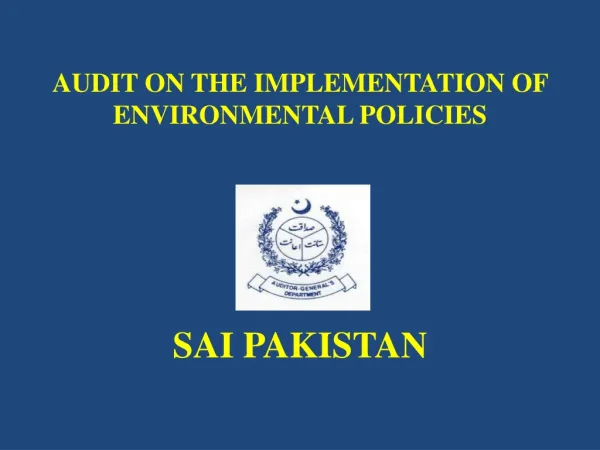
AUDIT ON THE IMPLEMENTATION OF ENVIRONMENTAL POLICIES SAI PAKISTAN
AUDIT ON THE IMPLEMENTATION OF ENVIRONMENTAL POLICIES SAI PAKISTAN. BACKGROUND & INTRODUCTION. BACKGROUND. DIRECTORATE GENERAL OF AUDIT (FEDERAL GOVERNMENT) ISLAMABAD PLANNED ENVIRONMENTAL AUDIT IN AUDIT PLAN FOR THE YEAR 2009-10
507 views • 24 slides

EDUCATION System in Pakistan
EDUCATION System in Pakistan. 1. Constitution of Pakistan. 2. Constitution of the Islamic Republic of Pakistan, 1973 – Article 37-b. “ The State shall remove illiteracy and provide free and compulsory secondary education within minimum possible period”. Concurrent Legislative List:
8.43k views • 22 slides

RIGHT TO FREE AND COMPULSORY EDUCATION IN PAKISTAN
RIGHT TO FREE AND COMPULSORY EDUCATION IN PAKISTAN. A Struggle to Enforce Article25 A. Pakistan – Facts –Shifts.. . Population: 185 + million Provinces: 5 & 3 areas (FATA, ICT & AJK) Poverty & Vulnerability: 22% + 22% - volatile Emergencies: 2005 -2013 & ongoing
806 views • 18 slides

Education Policies and Structures
Education Policies and Structures. Their impact on the delivery of Gaelic Games. Session objectives. To appraise delegates of how the implementation of key DENI policies may impact on the delivery of Gaelic games
319 views • 20 slides
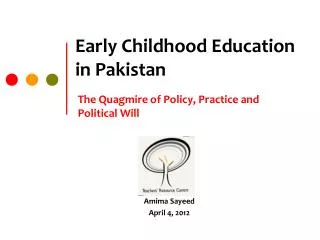
Early Childhood Education in Pakistan
Early Childhood Education in Pakistan. The Quagmire of Policy, Practice and Political Will. Amima Sayeed April 4, 2012. Policies and Provisions: What’s Been Achieved?. National Curriculum aligned with the developmental domains Contextualized, consultative and research based
2.28k views • 10 slides
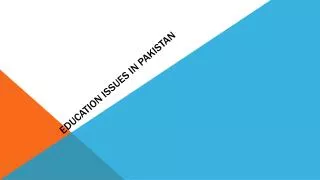
Education issues in Pakistan
Education issues in Pakistan. Uneducated in Pakistan. One out of ten primary school children that are uneducated is located in Pakistan. Pakistan is ranked second in global ranking of out-of-school children. 19.6 million children of primary school age, 6.8 million are not in primary school.
809 views • 9 slides
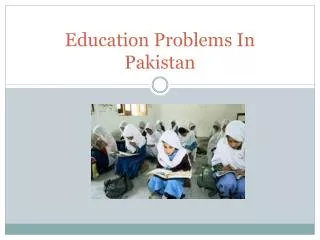
Education Problems In Pakistan
Education Problems In Pakistan. Introduction. Around the world, there are many countries that deny education to certain groups of people because of certain believes and mind sets on what they should not do.
3.69k views • 9 slides
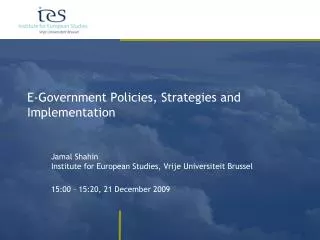
E-Government Policies, Strategies and Implementation
E-Government Policies, Strategies and Implementation. Jamal Shahin Institute for European Studies, Vrije Universiteit Brussel 15:00 – 15:20, 21 December 2009. eGovernment. Trends Infrastructure to services to applications. Towards governance. Government for all.
228 views • 13 slides
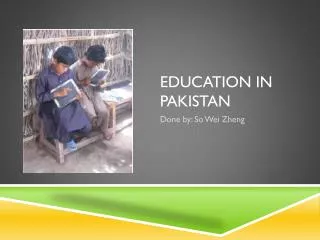
Education in pakistan
Education in pakistan. Done by: So Wei Zheng. deprivation of education (statistics). 51% of Pakistanis are deprived of basic education and health. Between 2000-2004, literacy rates in ages 55-64 was 38%. 45-54 was 46%, 25-34 was 54%, and 15-24 was nearly 57%.
479 views • 10 slides

EDUCATION System in Pakistan. 5 December , 2008. 1. Contents. PART - I Constitution of Pakistan Organization & Functions PART – II Education Scenario Financing Education Policy Other Programmes. 2. Constitution of Pakistan. 3.
2.69k views • 52 slides

ICT in Education Policies
ICT in Education Policies. Looking at good practices in Europe. Presentation. EC Working Group ICT in education Criteria for selecting good policies Contributions: 58 «Good policy examples» Criteria used in contributions Problematic dimensions in integrating ICT in education Key issues.
329 views • 16 slides
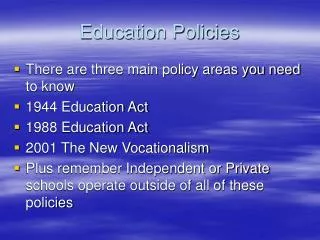
Education Policies
Education Policies. There are three main policy areas you need to know 1944 Education Act 1988 Education Act 2001 The New Vocationalism Plus remember Independent or Private schools operate outside of all of these policies. 1944 Education Act. Introduction of the Tripartite System
175 views • 6 slides
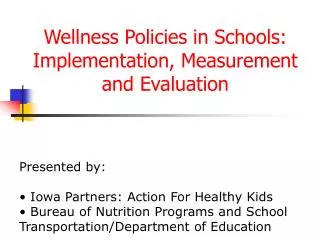
Wellness Policies in Schools: Implementation, Measurement and Evaluation
Wellness Policies in Schools: Implementation, Measurement and Evaluation. Presented by: Iowa Partners: Action For Healthy Kids Bureau of Nutrition Programs and School Transportation/Department of Education.
760 views • 58 slides

UNIVERSAL PRIMARY EDUCATION IN PAKISTAN
UNIVERSAL PRIMARY EDUCATION IN PAKISTAN. AZHAR IQBAL KHAN M.Phil Student Iqra University , 01 December , 2013. 2. Constitution of Pakistan. 3. Constitution of the Islamic Republic of Pakistan, 1973 – Article 37-b.
2.24k views • 33 slides
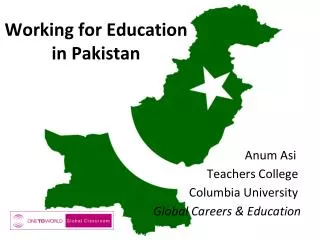
Working for Education in Pakistan
Working for Education in Pakistan. Anum Asi Teachers College Columbia University Global Careers & Education. Wh at continent is my country on?. Enlarge the map of your continent. Karachi.
454 views • 25 slides
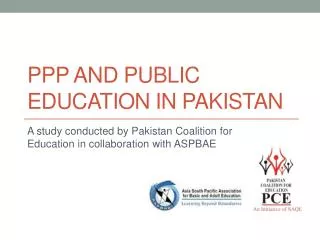
PPP and Public Education in Pakistan
PPP and Public Education in Pakistan. A study conducted by Pakistan Coalition for Education in collaboration with ASPBAE. Introduction. The research is conducted by PCE with the support of in ASPBAE and OSF highlights the Public Private Partnerships (PPP) in Pakistan.
694 views • 23 slides

PRESENTATION TO ENVIRONMENTAL INITIATIVES AND UNFCCC IMPLEMENTATION IN PAKISTAN
GOVERNMENT OF PAKISTAN MINISTRY OF ENVIRONMENT. PRESENTATION TO ENVIRONMENTAL INITIATIVES AND UNFCCC IMPLEMENTATION IN PAKISTAN. ENVIRONMENTAL INITIATIVES AND UNFCCC IMPLEMENTATION IN PAKISTAN. By Mir Rehman SECTION OFFICER MINISTRY OF ENVIRONMENT ISLAMABAD.
294 views • 11 slides

Education Policies. Influx of Immigration. Eugenicists believed that immigrants were a major cause of poverty, disease, and societal decay
290 views • 23 slides
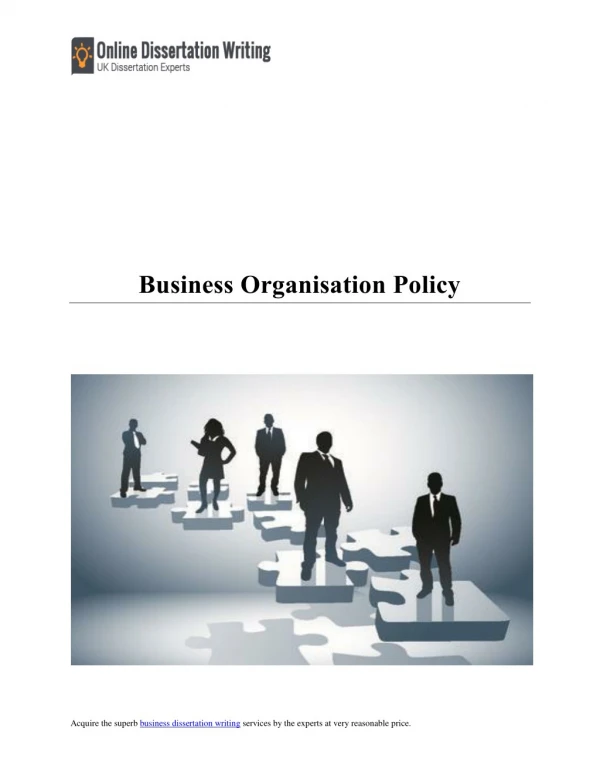
Various Policies and their Implementation in Business Organization
To run a business in successful way it is very necessary to implement proper policies like competitor analysis, strategies, research and many more. Read this report to learn about the role of effective business policies in organization with help of a case study about a shoes company.
145 views • 14 slides
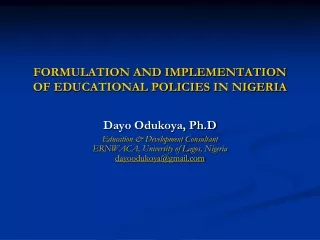
FORMULATION AND IMPLEMENTATION OF EDUCATIONAL POLICIES IN NIGERIA
FORMULATION AND IMPLEMENTATION OF EDUCATIONAL POLICIES IN NIGERIA. Dayo Odukoya, Ph.D Education & Development Consultant ERNWACA, University of Lagos, Nigeria [email protected]. Introduction/Background.
335 views • 27 slides

73 views • 6 slides

Implementation of Environmental Education Policies in the Hinterlands of Northern Samar
The perceptions of the faculty members, school officials and students in terms of the implementation of the environmental education policies in the hinterlands of Northern Samar specifically in Silvino Lobos, Northern Samar were analyzed in this work. A positive response on waste reduction and management and a rejection on the use of plastics and individual bulk packaging of products from suppliers were manifested. Further perceived was the disliking of artesian well as the source of water agreed on the composting biodegradables and the segregating waste in academic institutions and proper sealing of hazardous wastes before disposal. Eight 8 environment themes were integrated in the curriculum specifically in Music, Health and Physical Education, English, Social Studies, Filipino, and Mathematics, which run counter to the non availability of a general policy on environment by the local government unit. Environmental policy must be reflected in the vision and mission of the local government unit, as the schools follow and implement certain operational standards that are environment friendly, and integrate environmental education in most of the subjects. Felisa P. Lucero-Sanico "Implementation of Environmental Education Policies in the Hinterlands of Northern Samar" Published in International Journal of Trend in Scientific Research and Development (ijtsrd), ISSN: 2456-6470, Volume-3 | Issue-3 , April 2019, URL: https://www.ijtsrd.com/papers/ijtsrd22930.pdf Paper URL: https://www.ijtsrd.com/other-scientific-research-area/enviormental-science/22930/implementation-of-environmental-education-policies-in-the-hinterlands-of-northern-samar/felisa-p-lucero-sanico
64 views • 6 slides

- High contrast
- Work with us
- Press Centre
Search UNICEF
Giving every child the right to education.

Pakistan is facing a serious challenge to ensure all children, particularly the most disadvantaged, attend, stay and learn in school. While enrollment and retention rates are improving, progress has been slow to improve education indicators in Pakistan.
An estimated 22.8 million children aged 5-16 are out-of-school.
Currently, Pakistan has the world’s second-highest number of out-of-school children (OOSC) with an estimated 22.8 million children aged 5-16 not attending school, representing 44 per cent of the total population in this age group. In the 5-9 age group, 5 million children are not enrolled in schools and after primary-school age, the number of OOSC doubles, with 11.4 million adolescents between the ages of 10-14 not receiving formal education. Disparities based on gender, socio-economic status, and geography are significant; in Sindh, 52 percent of the poorest children (58 percent girls) are out of school, and in Balochistan, 78 percent of girls are out of school.
Nearly 10.7 million boys and 8.6 million girls are enrolled at the primary level and this drops to 3.6 million boys and 2.8 million girls at the lower secondary level.
Gender-wise, boys outnumber girls at every stage of education.
Gaps in service provision at all education levels is a major constraint to education access. Socio-cultural demand-side barriers combined with economic factors and supply-related issues (such as availability of school facility), together hamper access and retention of certain marginalized groups, in particular adolescent girls. Putting in place a credible data system and monitoring measures to track retention and prevent drop-out of out-of-school children is still a challenge.
At systems level, inadequate financing, limited enforcement of policy commitments and challenges in equitable implementation impede reaching the most disadvantaged. An encouraging increase in education budgets has been observed though at 2.8 percent of the total GDP, it is still well short of the 4 percent target.

In order to accelerate progress and ensure the equitable expansion of quality education, UNICEF supports the Government of Pakistan’s efforts to significantly reduce the number of OOSC at pre-primary, primary and lower secondary levels. Our education programme is focusing on Early Childhood Education (ECE) to improve school readiness; expansion of equitable and quality alternative learning pathways (ALP) at basic education levels; and nurturing of school-community linkages to increase on-time enrolment, reduce drop-outs, and ensure completion and transition for all students. At systems levels, we are contributing to more equity-focused provincial sector planning and budgeting; strengthening data and assessment systems; and evidence-based policy advocacy.
Early Childhood Education (ECE)
Investment in quality early learning/pre-primary education so that young children are ‘ready for school’ has high positive impacts on primary school enrolment, survival and learning, and is cost-effective.
The benefits of ECE are highest for children from poor and vulnerable households.
Given the limited reach and inequities in the provision of pre-primary education, Pakistan is increasingly recognizing early learning as a policy priority, and several provinces have already developed ECCE policies, plans, and standards.
Alternative Learning Pathways (ALP)
While several models exist for ALPs, these are still scattered and limited in scale. UNICEF is addressing the issue of OOSC through studies, supporting provincial sector plan development, development or review of non-formal education policy and direct programme implementation. This wealth of experience now provides the evidence, know-how, and momentum for UNICEF to support federal and provincial governments in broadening ALPs within education systems to bring OOSC into primary education, with a specific focus on adolescent girls.
School-Community Linkages
Socio-cultural demand-side barriers combined with economic factors together drive education deprivation for certain groups of children in Pakistan, particularly girls. These barriers are further exacerbated by a lack of parental awareness of early learning, importance of on-time enrolment, and lack of social protection schemes. UNICEF is therefore focusing more closely on the obstacles to on-time enrolment, retention, completion and transition.
Equity in Education
Equity-based investments by government continue to be the key way to ensure education systems include the most disadvantaged girls and boys. Considering insufficient and ineffective allocation of budgets, UNICEF strategically engages in sector planning, to capitalise on opportunities to influence decision-making on equity issues.
UNICEF’s growing technical capacity and focus on assessment of learning, and international expertise also provides an opportunity to add value to Pakistan’s efforts to improve assessment systems. System reforms help in improving accountability and evidence-based decision making. UNICEF supports healthy dialogue on education budgeting and public financing, to highlight areas of improvement for better planning and improvement in the education sector.

World's Largest Lesson 2021
Early Childhood Education
New home, new friends
I wish I was
It's my kite
Can we be friends?
Saying Goodbye
Living and learning together
Choti's Adventures
Reports and Data
Pakistan Education Statistics 2016-17
Out of School Children in Azad Jammu & Kashmir Report , UNICEF, December 2016
Out of School Children in Azad Jammu & Kashmir, Fact Sheet , UNICEF, December 2016
Out of School Children in Gilgit-Baltistan Report , UNICEF, December 2016
Out of School Children in Gilgit-Baltistan, Fact Sheet , UNICEF, December 2016
Review of Alternative Learning Programmes in Pakistan 2014-15
Simulations for Equity in Education (SEE) Balochistan Model Factsheet , UNICEF, December 2016
Social Cohesion and Resilience booklet
Access to Education and Social Cohesion in Pakistan-Summary of findings from End line survey , UNICEF, December 2017
Pakistan OOSC Study. UNICEF, 2013
South Asia Regional Study on OOSC. UNICEF, 2014
The Investment Case for Education and Equity. UNICEF, 2015
Brought to you by:

Primary Education in Pakistan: Show Me the Evidence
By: Anjani Datla, Asim Khwaja
This case has two parts, a text-based case and a supplemental PowerPoint presentation. The case traces the evolution of an evidence-based research study on the education sector in Pakistan. In 2003,…
- Length: 5 page(s)
- Publication Date: Apr 30, 2014
- Discipline: Business & Government Relations
- Product #: HKS772-PDF-ENG
What's included:
- Teaching Note
- Educator Copy
- Supplements
$4.95 per student
degree granting course
$8.95 per student
non-degree granting course
Get access to this material, plus much more with a free Educator Account:
- Access to world-famous HBS cases
- Up to 60% off materials for your students
- Resources for teaching online
- Tips and reviews from other Educators
Already registered? Sign in
- Student Registration
- Non-Academic Registration
- Included Materials
This case has two parts, a text-based case and a supplemental PowerPoint presentation. The case traces the evolution of an evidence-based research study on the education sector in Pakistan. In 2003, Atish (fictionalized character), a Pakistan-born, Harvard educated economist returns to his native Pakistan to help reform a lagging education system. But Atish unearths conflicting information on the state of education in his country. Despite large investments, government-run schools are failing to provide quality education. And international media coverage asserts that the educational void in Pakistan is rapidly being filled by madrassas, or religious schools, that are designed to train children in extremism. Upon closer scrutiny, Atish finds holes in the madrassa enrollment numbers. Similarly, Atish learns that affordable private schools have sprung up across the country, yet no nationwide analysis on the quality of education they provide exists. In rural Pakistan, he also learns to suspect conventional wisdom regarding parental involvement and interest in educating their children. Before he can develop policy recommendations, Atish will have to separate fact from anecdotal information to understand the education landscape in Pakistan. Case number 2003.0
Learning Objectives
Using sound empirical data is crucial to developing effective policy. Atish's experience in Pakistan brings to the forefront the importance of seeking and using valid data as the building blocks of evidence-based policy. The case enables students to understand key factors of high-quality data such as reliability, validity and measurability and teaches them to apply an analytical framework when trying to influence policy spheres.
Apr 30, 2014
Discipline:
Business & Government Relations
Geographies:
Harvard Kennedy School
HKS772-PDF-ENG
We use cookies to understand how you use our site and to improve your experience, including personalizing content. Learn More . By continuing to use our site, you accept our use of cookies and revised Privacy Policy .

In Pakistan, Quality Education Requires A Different Approach—and More Investment
Juan d. barón.
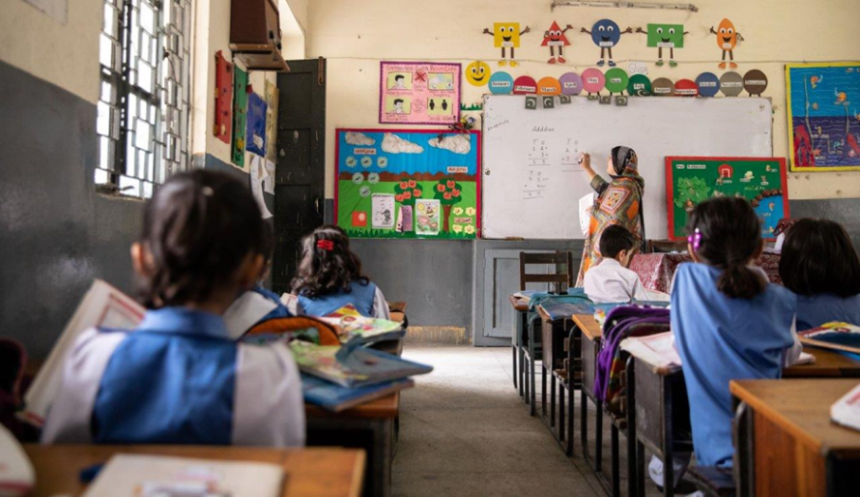
Our recent Human Capital Review highlights that quality education for all children in Pakistan will require a different approach and substantial financial efforts, estimated to be 5.4 percent of the Gross Domestic Product (GDP).
Low public spending on education, combined with limited effectiveness at producing positive student outcomes, such as universal school enrollments and effective learning, limits Pakistan’s citizens from more actively participating in economic and social activities and contributing to productivity and economic growth. The challenges –notably the large number of out-of-school children and high learning poverty–seem complex the costs of addressing them unsurmountable. Nevertheless, there are actions Pakistan can take to change this trajectory.
Low public spending on education limits Pakistan's citizens from more actively participating in economic & social activities. There are actions Pakistan can take to change the trajectory.
Pakistan’s education sector faces critical challenges, which are believed to have been deepened by COVID-19 and the 2022 Floods . These catastrophes have only added to the world’s second-highest population of out-of-school children, which was at 20.3 million before them. Even before the pandemic, Pakistan had 75% Learning Poverty, which means that prior to the floods it started with already a very high percentage of 10-year-olds that cannot read and understand a simple age-appropriate text. The most vulnerable are disproportionately affected by the sector’s challenges. For example, learning poverty is highest for the poorest, and the most impoverished children – mainly in rural areas – are more likely to be out of school.
A different approach would require using available information to better target education programs in order to maximize the impact of limited resources.
For example, conversations and analyses tend to group all out-of-school children into a single category. This severely limits the effectiveness of policy actions to reduce out-of-school children. Understanding the different characteristics of out-of-school children will help, and here are some of them:
- The majority are girls. Before the pandemic, 37 percent of girls and 27 percent of boys aged 5–16 were not in school.
- They are more likely to live in rural areas. About 35 percent—or 15 million-- rural children aged 5 to 16 were out of school, compared with 20 percent –or 4.4 million--of urban children. This gap has remained constant over the past two decades.
- They tend to be older. More children are out after primary school. During the 2018/19 school year, 40 percent of secondary school-age children were out of school (40 compared to 25 percent of middle school-age children and 23 percent of primary school–age children.
- The number and share of out-of-school children drastically differs across provinces. About 53 percent of all out-of-school children live in Punjab and 23 percent in Sindh. That is almost 14 million. However, Balochistan and Sindh show the country's highest provincial rates of out-of-school children.
A different approach not only targets out-of-school children more effectively, but also calls for a relentless focus on learning in everything the education sector does. The statistics in Pakistan are telling: 65 percent of students still need to achieve a minimum proficiency level in reading by the end of primary education ( Learning Poverty Brief ).
There are several barriers to learning. Research points to outdated teaching practices, lack of quality and availability of pedagogical material, difficulty transitioning from languages spoken at home to the language used in schools, and teacher shortages. In addition, poverty, undernutrition, lack of school readiness, and distance to school make learning more challenging for students.
A different approach and implementing programs for impact would require at least three elements. First, it requires policies and solutions tailored to the characteristics of distinct groups of out-of-school children to maximize impact. For example, bringing children who are in the 13-16 age range and who have never been in school to regular school does not answer their needs. Alternatively, providing these children with literacy, numeracy, and life skills would support their needs in life.
Second, it requires focusing on what works. There is plenty of evidence from Pakistan and elsewhere that highlight the policy options and programs that are the most cost-effective to increase enrollment and learning, but prioritizing which ones to implement is critical. Third, it will require increasing the efficiency and level of public expenditure, this can be achieved by targeting funding every year to where education outcomes are the lowest.
There are several tested and impactful approaches that Pakistan has used successfully and that can deliver results at a reasonable cost. These can be scaled to expand educational services for children in Pakistan.
A few examples here can have a real impact. First, public-private partnerships have worked in Punjab. They can be expanded to cover more children in other levels of the system, particularly middle school, but be better regulated. Second, public and community schools can be revamped and improved, ensuring teachers are present – including consideration of double shifts when appropriate in the public sector. Third, multigrade classrooms should take true multigrade approaches in terms of funding, planning, and pedagogical execution. Making multigrade more effective is necessary to make rural education affordable and impactful. Several countries have done it successfully, including Pakistan, in the past.
Finally, the Human Capital Review provides a back-of-the-envelope estimate of how much Pakistan would require to keep all children in school – with gains in quality: 5.4 percent of GDP. This is assuming increases in efficiency in the public sector of 20 percent, for example, by using more targeted programs, investing in cost-efficient programs, and minimizing the use of high-cost, low-impact programs such as laptop distribution with no underlying pedagogical strategy .
An increase in expenditure is necessary from the low base of 2.5 percent of GDP Pakistan currently spends on education. Expanding levels of education should go in parallel with a serious effort to increase the efficiency of public expenditure in access, quality, and equity. Just bringing children to school is not enough. They must learn the skills to contribute to their own lives, families, communities, and country.
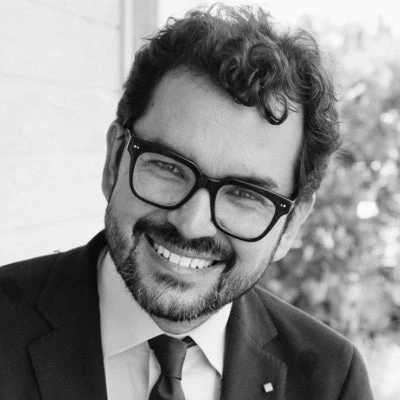
Senior Economist, Education Global Practice, World Bank Group

Senior Consultant
Join the Conversation
- Share on mail
- comments added
Paving the Way to Education and Opportunity in Pakistan
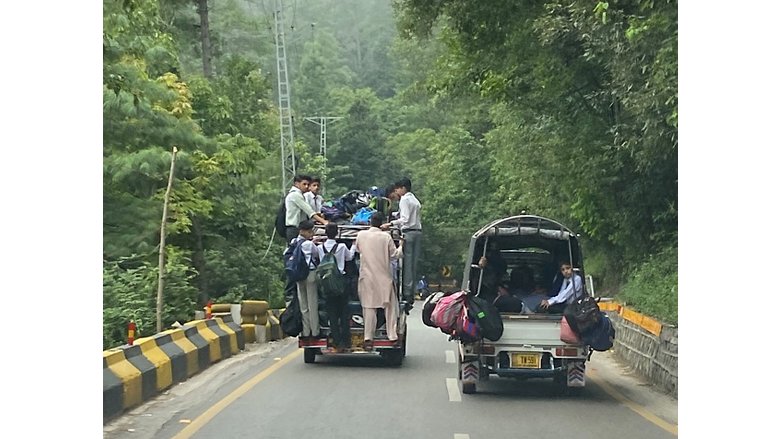
Transport in Khyber Pakhtunkhwa, Pakistan.
- The World Bank is helping upgrade some 650 kilometers of rural roads in Khyber Pakhtunkhwa, a mountainous province in northwestern Pakistan
- The project will boost development across the province by providing a reliable year-round accessibility to schools, healthcare centers, markets, and other key opportunities
- The project team conducted extensive data analysis to identify accessibility gaps combined with field work to identify the major transport barriers that deters access to education for girls and its development benefits
Bitumen. Asphalt. Concrete. Gravel. These are the components of a road, but they aren’t the parts that matter for the people who use them. What matters is access to schools, health care services, and markets. In Pakistan’s Khyber Pakhtunkhwa Province, or KP for short, safe roads can mean for girls the difference between going to school or staying home, between seeing a healthcare provider or getting sicker, between selling wheat or vegetables for a healthy profit at market or selling too cheaply to neighbors.
Accessibility is the premise behind the World Bank’s Khyber Pakhtunkhwa Rural Accessibility Project, or KPRAP, which aims to better link 1.7 million people in a remote, mountainous region of Pakistan to the services and opportunities in towns and cities nearby. Specifically, the $300-million program will finance the upgrading of 45 road sections with a total length of approximately 650kilometers.
“In KP, all-weather rural roads play a key role in accessibility to basic services and connecting districts to provincial centers, but almost 41 percent of the road network is in poor condition and almost 20 percent is not paved,” said Lincoln Flor , one of the Word Bank Senior Transport Specialists supervising the project. “By providing better and more reliable road access, the KPRAP project will make a significant difference in the daily lives of residents, especially for girls in the poorest and most remote parts of KP.”
One major focus of the project is getting girls and boys to school. The project’s new and improved roads will benefit 65,000 girls in five districts, allowing them to get to school faster, on better and safer roads. Long home-to-school commutes and difficult road conditions disproportionately keep girls out of the classroom . In some districts in KP, more than 70 percent of girls are out of school, as compared to 30 percent of boys . Pakistan Communication and Works Department of KP data shows that for nearly half of the province’s rural population, school is far-- more than a 30-minute drive away. Ten percent of people in KP live more than a two-hour drive from an urban center.
Getting girls to school is a priority in Pakistan, which has the second largest out-of-school population of any country. Nearly 23 million Pakistani children aged 5 to 16 do not attend school. Aside from teacher shortages, distance to school and safety are the largest barriers to accessing education in rural areas, with 29 percent of parents saying that schools are simply too far away. Girls are twice as likely to skip school in rural areas as compared to their urban peers, from 43 percent in the countryside versus 21 percent in cities and towns. This gap is even more pronounced in middle and higher education.
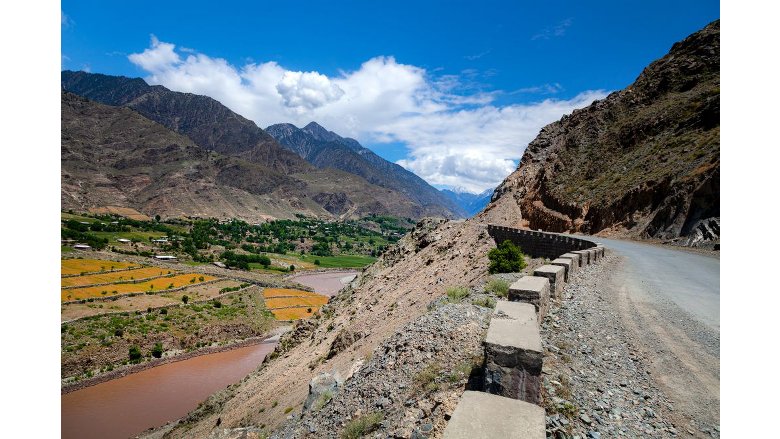
Accessibility is the premise behind the World Bank’s Khyber Pakhtunkhwa Rural Accessibility Project.
Shutterstock
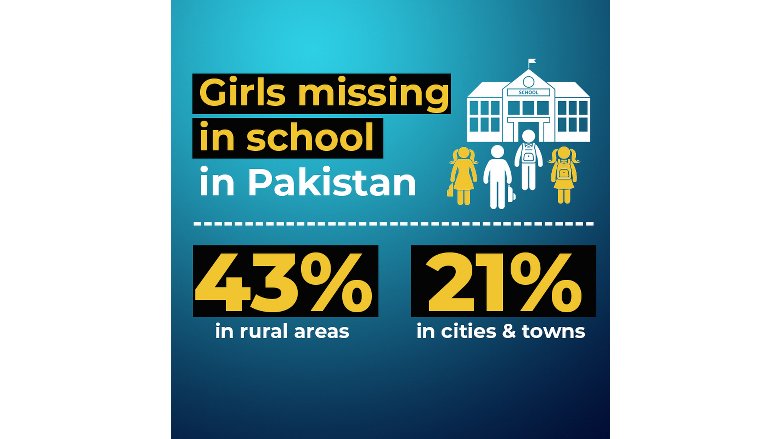
Source: World Bank
Better access to education is just one of many potential benefits. “The team worked closely with the government to carry out a comprehensive geospatial analysis which identified locations with the lowest accessibility and highest gender disparities,” said Hasan Afzal Zaidi , a World Bank Senior Transport Specialist who is co-leading the project. “Our analysis showed that Districts in North, South and in erstwhile FATA in KP were the locations where improved rural access could have the biggest impact.”
Many factors play a role in improving accessibility, of course. Compared to the rest of Pakistan, KP is especially vulnerable to climate change because of its terrain and topography, so building roads with climate resilience is a key part of the project. In winter, snow and ice block roads, while during the monsoon season travelers face the risk of floods and landslides. More resilient roads will help local communities navigate these conditions and will provide all-weather access to crucial services, like schools, health care, and markets. When disaster strikes, resilient roads will also ensure continued access for emergency services and will reduce reconstruction costs.
Geospatial analysis by the WB team showed that almost 40 percent of the rural population in KP has to travel more than an hour to get to a health center. Barriers like travel time and distance are linked to higher numbers of deaths and disease from conditions that are treatable. Household data shows that lack of transport and long distances deter people, especially women of childbearing age, from getting the care they need.
Providing farmers and merchants with better access to markets is also an important part of the project. Eighty five percent of KP’s population relies on agriculture for their livelihoods, and bad roads, which make for time-consuming and expensive transport, hurt small farmers. This, combined with lack of adequate storage, can lead to expensive postharvest losses for farmers.
This focus on KP is part of an overall WB push to use data to better inform its investment decisions, like locations for new schools and transport upgrades. It builds on earlier, and similar, accessibility projects in Afghanistan, Nepal, Sri Lanka, Bhutan, and Bangladesh. For both the World Bank and for governments around the globe, accessibility analyses like those used in KP are fast becoming core inputs into transport infrastructure planning and policies.
Last Updated: Sep 08, 2022
World Bank Transport
World Bank Pakistan
This site uses cookies to optimize functionality and give you the best possible experience. If you continue to navigate this website beyond this page, cookies will be placed on your browser. To learn more about cookies, click here .
Ethics and Education in Pakistan: Principles, Policies and Practice
- First Online: 09 December 2016
Cite this chapter
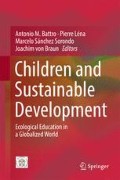
- Manzoor Hussain Soomro 5 &
- Saima Huma Tanveer 5
1289 Accesses
2 Citations
Ethics is a code of conduct, that an individual, group or society holds as definitive, in differentiating right and wrong. Pakistan as per its constitution, follows the Islamic principles as guiding path. In Islam, the concept of taqwa means the moral ground that underlies human actions and signifies the ethical sense which makes human beings aware of their responsibility to God and the society. The concept of social life of the Prophet of Islam—Muhammad (Peace be upon Him—PBUH); to whom, God in Quran called Rahmatul - lil - Aalameen (Blessing for the World), is very much positive and constructive. According to him, the loftiest service is the service to humanity. To serve humanity in an appropriate manner, the better way is to guide him; or in a broader term, educate him. The Quran’s first revealed verse began with the word “ Iqra’a ” meaning—“ read ”. It is thus surprising that some people in the name of Islam, destroy centers of learning, schools and mosques, and also shoot at girls who go to school. The reason may not be simple but the lack of education and perhaps vested interests, feeling threatened from the “educated” people, who try to find the truth, may be some of the major reasons.
- Private School
- Religious Education
- Moral System
- High Education Commission
- 18th Amendment
These keywords were added by machine and not by the authors. This process is experimental and the keywords may be updated as the learning algorithm improves.
This is a preview of subscription content, log in via an institution to check access.
Access this chapter
- Available as PDF
- Read on any device
- Instant download
- Own it forever
- Available as EPUB and PDF
- Compact, lightweight edition
- Dispatched in 3 to 5 business days
- Free shipping worldwide - see info
- Durable hardcover edition
Tax calculation will be finalised at checkout
Purchases are for personal use only
Institutional subscriptions
Ahmed, D. (2015). Can fundamentalism in Pakistan be traced back to Madrasah? http://defence.pk/threads/can-fundamentalism-in-pakistan-be-traced-back-to-madrasah.385056/#ixzz3xrCaTyJd . Accessed 26 May 2016.
Alam, M. (2014). A policy note on “Universal Primary Education in Pakistan” national and provincial progress towards Universal Primary Education MDGs targets, Challenges and Possible Solutions. Public Policy Note 05/2014, Institute of Public Policy, Beaconhouse National University. http://www.sjbipp.org/PN/PN%2005-2014.pdf . Accessed 26 May 2016.
Alif Ailaan. (2014). 25 Million Broken Promises: The crisis of Pakistan’s out-of-school children. Alif Ailaan, Islamabad. ISBN 978-969-23023-0-2. https://d3n8a8pro7vhmx.cloudfront.net/alifailaan/pages/540/attachments/original/1422009988/Alif_Ailaan_report_25_million_broken_promises.pdf?1422009988 . Accessed 26 May 2016.
Al-Qur’an: The Holy Quran Arabic text with translation in english text and search. https://www.alislam.org/quran/search2/ Accessed 26 May 2016.
Andrabi, T., Das, J., & AI Khwaja (2008). A dime a day: The possibilities and limits of private schooling in Pakistan. Comparative Education Review. Electronically published by the Comparative and International Education Society, May 28, 2008. http://www.hks.harvard.edu/fs/akhwaja/papers/PrivateSchool_CER.pdf . Accessed 25 May 2016.
Bhatti, M. A., Bano, S., Khanam, F., & Hussain, A. (2011). Problems in the Implementation of National Education Policies (NEPs) at elementary level. Academy of Educational Planning and Management (AEPAM), Ministry of Education, Government of Pakistan, Islamabad. http://library.aepam.edu.pk/Books/Problem%20in%20the%20Implementation%20of%20National%20Education%20Policies%20at%20Elementary%20Level.pdf . Accessed 26 May 2016.
Butt, T. M. (2012). Social and political role of Madrasah: Perspectives of religious leaders in Pakistan. South Asian Studies, 27 (2), 387–407. http://pu.edu.pk/images/journal/csas/PDF/6.%20Tahir%20Mehmood%20Butt_V28_no2_12.pdf . Accessed 26 May 2016.
HEC. (2015). Pakistan qualification frame work. Higher Education Commission (HEC), Pakistan. http://www.hec.gov.pk/insidehec/divisions/qali/qadivision/pages/pqr.aspx . Accessed 25 May 2016.
HEC. (2016). Social integration outreach programme for universities, Higher Education Commission (HEC), Pakistan. http://epaper.dawn.com/Advt.php?StoryImage=07_02_2016_006_005 . Accessed 26 May 2016.
I-SAPS. (2012). Eighteenth amendment: Federal and provincial roles and responsibilities. Institute of Social and Policy Sciences, Islamabad, Pakistan. http://aserpakistan.org/document/learning_resources/2014/18th%20Amendment%20Federal%20and%20Provincial%20Responsibilities%20in%20Education.pdf . Accessed 25 May 2016.
Kamal, S. (2014). Madrasah education: A threat to peace and tolerance. http://www.dailytimes.com.pk/opinion/25-Jan-2014/madrassa-education-a-threat-to-peace-and-tolerance . Accessed 26 May 2016.
Khalidy, A. (2008). The nature of Islamic moral and the moral of prophet. http://www.academia.edu/9557014/the_nature_of_islamic_moral_and_the_moral_of_Prophet . Accessed 25 May 2016.
Khan, M. (2015). Women rights in Islam—A true picture. http://www.bookhut.net/women-rights-in-islam-status-role/ . Accessed 25 May 2016.
Khattak, K. (2015). New schools through public private partnership. http://www.thenews.com.pk/print/45968-new-schools-through-public-private-partnership . Accessed 25 May 2016.
Malik, A. A., & Hussain, E. (2015). Tolerance through education. http://csscurrentaffairs.pk/tolerance-through-education-by-asif-a-malik-and-ejaz-hussain/ . Accessed 25 May 2016.
MET&SHE. (2014). Education for all 2015—National review report: Pakistan. Ministry of Education, Trainings and Standards in Higher Education. http://unesdoc.unesco.org/images/0022/002297/229718E.pdf . Accessed 25 May 2016.
OECD. (2013) What are the social benefits of education? Education Indicators in Focus , No. 10, OECD Publishing, Paris. doi: 10.1787/5k4ddxnl39vk-en . Accessed 25 May 2016.
PILDAT. (2015). Report on Madrasah education (2014) Challenges, reforms and possibilities. Pakistan Institute of Legislative Development and Transparency—PILDAT (2015). ISBN: 978-969-558-484-2. http://pildat.org/youthparliament/yp2014/downloads/CR/educationandyouthaffairsstandingcommitteereport.pdf . Accessed 26 May 2016.
Questions on Islam. (2009). High ethics and good manners of Hazrat Muhammad. http://www.questionsonislam.com/article/8-high-ethics-and-good-manners-hazrat-muhammad . Accessed 25 May 2016.
Rajper, R. (2015). The sorry state of education in Pakistan. In S. Ahmed (Ed.) Spatial knowledge and information management (SKIM) (No. 2, pp. 16–19). Islamabad: Alhasan Systems Private Limited. http://csscurrentaffairs.pk/sorry-state-of-education-in-pakistan/ . Accessed 26 May 2016.
Riazul Haq. (2014). Gloomy Picture: 25 m children out of school says new report. http://tribune.com.pk/story/779119/gloomy-picture-25m-children-out-of-school-says-new-report/ . Accessed 26 May 2016.
SAFED. (2015). Annual Status of Education Report (ASER) Pakistan 2015. South Asian Forum for Education Development (SAFED), ISBN: 978-969-04-5.
Google Scholar
Saulat. (2014). Morality and ethics in Islam. http://www.whyislam.org/social-values-in-islam/morality-ethics-in-islam/ . Accessed 25 May 2016.
Shaukat, Q. (2012). The equality of education for men and women in Islam. http://saypeople.com/2012/05/22/the-equality-of-education-for-men-and-women-in-islam/ . Accessed 25 May 2016.
Uzmi, Z., & Nakhoda, S. (2015) The constitution of Pakistan. http://www.pakistani.org/pakistan/constitution/preamble.html . Accessed 25 May 2016.
Download references
Author information
Authors and affiliations.
Economic Cooperation Organization Science Foundation (ECOSF), 5th Floor, MoST Building, 1- Constitution Avenue, Sector G-5/2, Islamabad, 44000, Pakistan
Manzoor Hussain Soomro & Saima Huma Tanveer
You can also search for this author in PubMed Google Scholar
Corresponding author
Correspondence to Manzoor Hussain Soomro .
Editor information
Editors and affiliations.
Academia Nacional de Educación, Buenos Aires, Argentina
Antonio M. Battro
Université Paris Diderot, Paris, France
Pierre Léna
The Pontifical Academy of Sciences, Vatican City, Holy See (Vatican City State)
Marcelo Sánchez Sorondo
Center for Development Research, University of Bonn, Bonn, Germany
Joachim von Braun
Rights and permissions
Reprints and permissions
Copyright information
© 2017 Springer International Publishing AG
About this chapter
Soomro, M.H., Tanveer, S.H. (2017). Ethics and Education in Pakistan: Principles, Policies and Practice. In: Battro, A., Léna, P., Sánchez Sorondo, M., von Braun, J. (eds) Children and Sustainable Development. Springer, Cham. https://doi.org/10.1007/978-3-319-47130-3_29
Download citation
DOI : https://doi.org/10.1007/978-3-319-47130-3_29
Published : 09 December 2016
Publisher Name : Springer, Cham
Print ISBN : 978-3-319-47129-7
Online ISBN : 978-3-319-47130-3
eBook Packages : Education Education (R0)
Share this chapter
Anyone you share the following link with will be able to read this content:
Sorry, a shareable link is not currently available for this article.
Provided by the Springer Nature SharedIt content-sharing initiative
- Publish with us
Policies and ethics
- Find a journal
- Track your research

- Cover Stories
- Stocks Analysis
- PAGE Reports
Previous Editions
- Archive Articles 2023
- Archive Articles 2022
- Archive Articles 2021
- Archive Articles 2020
- Archive Articles 2019
- Archive Articles 2018

Education in Pakistan: problems, challenges and perspectives

Quaid-e-Azam Muhammad Ali Jinnah said and I quote:
“Education is a matter of life and death for Pakistan. The world is progressing so rapidly that without requisite advance in education, not only shall we lag behind others but maybe wiped out altogether.”
The education section of the executive summary of the Economic Survey of Pakistan 2021-22 notes: “Pakistan is committed to transform its education system into a high-quality global-market demand-driven system in accordance with Goal 4 of the Sustainable Development Goals (SDGs) .” However, the reality is vastly different.
The literacy rate in Pakistan in 2021 was only 62.8%. Any gains in literacy rates over the last many years have been small, slow and marginal.
In 2021-22, we spent only 1.77% of GDP on education-related expenditure at both the federal and provincial levels. Most UN agencies recommend that the minimum expenditure on education should be 4% of GDP. In recent years, the highest percentage of GDP we have spent on education was in 2017-18, when education expenditures were raised to 2.12%. The usual argument given for lack of spending on education has always been and still is that we do not have the resources.
In Pakistan, the current literacy rate is 62.3%. In Budget 1.7% of GDP has been allocated as Education Budget which is lowest in the region. The expenditure of Rs 74,609 billion has been allocated for Tertiary Education Affairs & Services in budget 2022-23; Rs 3,786 billion for pre-primary & primary education; Rs 8,863 billion for Secondary Education Affairs and Rs 2 billion for administration. Rs 44,174 billion has been earmarked for Higher Education Commission ( HEC ) under the Public Sector Development Program (PSDP) for the year 2022-23. (Business Recorder June 11, 2022).

According to data from the World Economic Forum’s Global Competitiveness Report 2017-18, the Global Competitiveness Index (GCI) shows Pakistan’s slow performance being ranked 129th of the 137 countries, on the Health and Primary Education related elements of competitiveness, when compared with other countries in the region like India, China, Bangladesh, Sri Lanka and Malaysia. The structure of school education system in the public sector is depicted in Fig. below.

Figure Above: The structure of school education system in Pakistan (Pre-Primary to Higher Secondary)
Education system creates sense of responsibility among people and they come to know the methods to achieve their national, societal and personal rights and it also enhances their general consciousness needed to deliver their duties as citizens towards their Nation. Once the realization originates, people start working for the development and prosperity of their motherland in the atmosphere of trust and co-operation.
The polarization and non – unified education system has resulted into outraged political turmoil, deadly terrorism, incessant sectorial violence, social disruption, economic instability and degeneration of government system. Whether it is poverty, non-availability of jobs, security uncertainty, sectarianism or terrorism, lack of tolerance, lack of general awareness, illiteracy, all are off shoots of the poor, inefficient and ineffective education system. The lowest budget allocation, a realm of large number of ineffective education policies has badly failed to take country out of economic, social, political and development quagmire.
Education has fundamental role in the economic, social, political and structural development of any nation. Many of the economic issues like poverty , overpopulation, unemployment , resource mobilization, inflation, exchange rate drastic fluctuation, housing, infrastructure, and health can be reduced and handled by improving education system in Pakistan. Education can also solve social issues like Baradari system, Wadera Culture, Chaudary regime and slave mentality. The political issues like battle for power by different politicians, lawlessness, fraud, corruption, religious riots, extremism, processions to gain popularity, use of indecent remarks, no public service, no human investment to save the lives of ignorant and deprived humans. Structural Development like transition from primitive methodologies to modern strategies; Shifts from Agriculture to Industry, hand made tools to mechanization, from physical conventional education system to Online Education and adoption of highly sophisticated and up to the mark technology can only happen with the strong Education Policy and implementation of country’s education system.
Pakistan, since its inception has failed to establish an education system which can fulfill the aspirations of the general public. Being a developing country, Pakistan is facing multifaceted problems and issues in the education sector. There are many issues prevalent and practiced in Pakistan’s Education System at all levels of Education – primary, secondary – colleges or universities.
The educational institutions within the country are divided into following categories: (1) Pre-primary School (2) Primary School (3) Middle School (4) High School (5) Higher Secondary (6) Inter-colleges (7) Degree Colleges (8) Universities (9) Non-formal Basic Education (10) Education foundations (11) Technical & Vocational Institutions (12) Teacher Training Institutions (13) Deeni Madaris
Pakistan’s schooling system consists of three main school types namely public sector schools, private sector schools and Deeni Madaris. These are further divided as public and private mainly due to curriculum and examination systems used in the schools and the language of instructions used by teachers.

The Broad Categories on education level are:
School Education (Pre-primary – Class 12) College Education (Degree Colleges Class 13-14) University Education
The education system of Pakistan is comprised of 305,763 institutions accommodating 51,186,560 9 students and 2,073,433 teachers. The system is composed of 189,748 (62%) public institutions and 116,015 (38%) private institutions, which also include 31,115 Deeni Madaris. The public sector is serving 28.49 million (56%) students to complete their education while the remaining 22.70 million (44%) are enrolled in the private sector of education. About 38 percent private educational institutions are facilitating 44 percent of students showing a slightly higher per-institution enrolment ratio in the private sector compared to the public sector.

There are a total of 186 universities & degree awarding institutions catering to the needs of higher degree students in both public and private sectors of education. Out of these universities, 111 (60%) are working under umbrella of public sector, whereas 75 (40%) are working in the private sector.

The total enrolment in the universities and degree awarding institutions is 1.576 million. Out of these 1.266 million (80%) students are enrolled in public sector whereas, 0.309 million (20%) students are studying in private universities and degree awarding institutions. In the overall national scenario only four percent students have access to university education. The total male enrolment in the universities is 0.881 million (56%), whereas, the female enrolment is 0.695 million (44%) . There are 56,885 teachers imparting higher education to the students in these universities. Universities in the public sector employ 38,011 (67%) teachers while those in the private sector have 18,874 (33%) teachers.
The significant issues of Education system are lack of Budget Allocation, lack of Policy Implementation, Faulty examination System, Poor Infra Structure of Educational Institutions, Lack of Teacher’s quality, low enrolment, Wayward and Directionless Education system, High scale drop outs, Increasing Political Interference, Out dated curriculum, corruption, Poor Management and Supervision, lack of Uniformity, lack of research, lack of faculty training and Development, Cost of Education, Terrorist Attacks, Cultural Constraints, lack of Parent input, Widening gap between Educational Institutions and Community, lack of Academia Industry Linkage program and Learning Crisis etc.
Education is the nurturing and nourishing force for the construction of strong and impressive societal set up, prominent development and significant growth of the country. Education explores new dimensions and polishes the hidden talent, potential, capabilities and strengths of individuals and redirect these forces towards the rise of Pakistan as a powerful nation on the global horizon.
Quaid-e-Azam Muhammad Ali Jinnah envisioned Education System of Pakistan as the driving force behind all the national goals. In the first National Education Conference held at Karachi. It was decided that Education System will work according to the National aspirations of Pakistan and it will be truly related to the needs of the people of Pakistan. The father of Nation said, “The magnificent goal of Education sector will be to develop character of Pakistan, high sense of responsibility, social integrity, selfless service to the Nation and morality on the part of the people of Pakistan.
Critical analysis of the problems and issues of education system in Pakistan.
These are the most dominant issues and problems of our Education System which needs to be addressed and to find remedial solutions for these issues and put forward recommendations for the positive change in our prevalent Education System.
1- Lack of uniformity
The Education System is not Uniform and is based on differentiated Education System like Public Institutions, Private Institutions and Deeni Madaris. There has been accelerated polarization in the Education System due to divisive Pakistani Education System. This has penetrated into cultural veins of the Nation. The recent waves of Sectarianism and Terrorism are the consequences of this divisible system. Polarized Education System has further divided society on political, economic and social grounds instead of uniting people. This division is leading towards further segregation on linguistic and religious levels and cutting knee deep the ideological foundation of the Nation.
2- Education without direction
A sound Education System is essential for every nation of the world. All nations develop their people or human resources on the basis of rigorous focus on Education and Training . We have poor and direction less education system with lack of cohesion and more prone towards general education without creation of Skillful man power resulting into massive unemployment. It also results into massive political, social, economic and cultural distress among people. There is no use of science and technology in the education system. Students are unable to develop critical thinking, creativity, imagination, reasoning, experimentation, innovation and invention
3- Outdated curriculum
We are still following the old fashioned and outdated Education System of rote memorization, cramming the facts and figures without realizing the holistic development of individuals. The objective of Education should be development of psychological, philosophical and sociological foundations of Education. The present curriculum is not motivating learners for practical research and development, scientific knowledge and reflective observation.

4- Lack of professional development of teachers
There are few training institutes but have lack of funds, lack of resourceful and trained trainers and administers. There are no defined standards of training and development. The courses and trainings are outdated, traditional without exposure to modern technology, motivation, quality of teachers and enhancement of skills .
5- Lack of quality teacher
According to UNESCO report, the quality of educational institutions and teacher is low. The situation is grimmer in remote parts of Punjab, Sindh, Balochistan where there is non availability of teachers. Teachers are not using new methods of teaching and learning, no lesson planning, old method of cramming, no research, no use of libraries or internet, no book reading. Students are promoted to next class on the basis of cramming and memorization of facts and figures without knowledge in depth, no conceptualization, no understanding of topics in the books without relevance in schools.
6- Alarming dropouts
Lack of management and discipline in schools leads many students to drop out from school. This trend is due to punishment in schools, poor parenting, lack of motivation, unattractive school environment, child labor & poverty are also very significant reasons of huge drop out from schools, colleges and universities. It shows that almost 30% of children enrolled in primary education. This trend has added to low literacy rate in Pakistan.
7- Examination system
Students are evaluated on the basis of annual exams, semester wise assessments. Both quantitative and qualitative exams should be introduced to judge the performance of students on comprehensive level and exams should evaluate the student’s ability through various types of reliable assessments like case studies, research papers, MCQs, Comprehensive subjective questions, Analytical questions to check the conceptual understanding of students especially in higher classes (Rehman, 2011).
In Pakistan examination system is faulty and it tests only the memory of students, there is use of unfair means, bribery, cheating, issuance of duplicate marks sheets, changes of marks, change of answer sheets, impersonation. This present examination system has promoted rote memorization and cramming. It has badly failed in producing critical thinking, analytical skills, learning, intellectual power and visionary reflection in the students at all levels of education. It does not measure the strength, achievements and performance of students (Quereshi, 1975).
Modular system of examination in Medical Universities is producing incompetent students with insufficient knowledge of Anatomy which is the backbone of medicine studies. In modular system a single paper for three subjects is given to students. Students prepare easy subjects to pass the exam and leave the difficult and important subject of Anatomy for choice. Therefore, this method has tarnished the strong foundations of learning and performing badly. Doctors produced with such type of examination with lack of proper understanding of subject will not be able to serve the humanity honestly and do the justice with their profession.
In our education system educational institutions are used as breeding grounds for political parties and in colleges and universities these groups nurture. Students get benefits by being part of any political party during exams. A list of students is provided to the teacher by the student leader to pass them in the exam, admissions are given on the party basis, exams are marked and checked on party basis because mostly teachers are also working for parties while sitting in educational institutions. During Board or University exam by giving money to the invigilator, students are allowed to cheat in the exam, Students throw question paper outside the window and one of the party rep climbs up the tree near the window with Megaphone and starts dictating answers by calling up question numbers. Honest Teachers are threatened and sometimes gunned and killed in case they are not willing to listen to the unfair demands of the students of different parties.
Some of the teachers are also involved in malpractices. They leak the paper by charging handsome amounts or solve the papers for students or allow students to solve the papers by cheating from books, material or from some good student. In board exams, before submission of sheets to the board office representative student is asked to write down correct answers. Teachers are themselves involved in such political activities and award “F” grade to students who are not in their party.
In Russia there is no exam system like ours. Students study through out the year and at the end of year teacher can ask any question from the book to pass the candidate and check his understanding & knowledge of the subject.
8- Poor supervision standards
To monitor teaching and learning, poor and harsh standards of evaluation and punishment are used which in some case leads to termination of jobs . At primary school level teacher’s evaluation is not possible. Secondary Schools/Cambridge Schools are evaluated through Board exam results/CAIE results. In college, again Board or University exam results are the criteria to judge the academic performance of Student and Teacher’s teaching. Whereas, actually there is an increase in tuitions instead of relying on School or College teaching. Students and their parents are compelled to go for tuitions due pressure of good grades and admissions in good educational institutions. There are many tuition centres, coaching centres, academies where the same teachers who were unable to impart quality education give quality tuitions by charging heavy amounts and prepare students well to score good grades. The low salaries demotivate them in their institutions to impart good education. In Universities students are given power to evaluate teaching and their grading becomes part of an Annual Evaluation Report which is essential for promotion or benefit of the faculty. This system is again polluted by involvement of computer department staff, Student coordinators and by bribing students to give bad remarks about any teacher. Some insincere and corrupt teachers mark students’ attendance and give them good marks, tell them questions of exams and do immoral activities to get good evaluation from students. Teachers who are honest and hard working are ranked low by students. Even at higher education institutions there is lobbying and politics through which false evaluation against any faculty can be prepared to get rid of the unwanted faculty by the management. So, in short, supervision system is more prone to harassment and control over the teaching staff rather than providing proper guideline and training for the improvement of teaching methodologies & strategies. (Rehman, 2011).
9- Internal and external influence
In Education sector external factors are coming outside the system through politicians and they bring changes in the system to give favor to their families, relatives, friends etc. Internal factors are bureaucratic manipulations (Mazhar, 2011).
There is great favoritism and Nepotism in cases of transfers, Appointments, Promotions, Salaries, Grades & Work Stations. Due to this the basic Infrastructure of the Education System in Pakistan has been badly affected (LOUIS, 1987).
10- Lack of resources
There are not proper Libraries with physical space for Students to Study. Books are not available, No digital libraries, no computer Facility in the library especially in public sector colleges & universities. No proper lighting, no AC, no Generators in case of power break down are available to make studies more comfortable for the desirous and ambitious students. Class rooms are over-crowded, corridors are flooded with students, Inadequate and Inefficient teachers, Laboratories without required apparatus & equipment of practical learning have resulted into a situation of despair and low standard of Education (Louis, 1987).
11- Lack of policy implementation
Frequent political turmoil and change of governments have made policy implementation in its true letter and spirit impossible. Corruption, Lack of Resources, Lack of teacher’s involvement in policies and inconsistency in successive planning on the part of various political regimes in Pakistan. Teachers are ignored while designing Education policies which has led to alienation between teachers and the system of Education (Zaki, 1989).
12- Low budgetary allocation for education
Education system in Pakistan has been crippled mainly due allocation of scarce financial resources in budget. The Education Budget which is definitely not sufficient to fulfill the growing needs of population and involvement of modern technology in the education system, low salaries, high taxation are also hindering the growth of this sector. Taxes are even imposed on the hourly payment of visiting faculty at the rate of ten percent from filers and twenty percent from non-filers which is really unjustified and reduces the meagre earning.
In many countries like Bangladesh & Sri Lanka the Education share in total budget of the country is increasing but in Pakistan it is continuously declining (Sayan, 2012).
13- Corruption
Corruption is another factor responsible for deterioration of the Education System, use of unfair means, nepotism, favors in transfer, promotion and appointments and decision making, misuse of funds, use of illegal authority by the school management, Gender based exploitation and harassment are the subsidiaries of corruption .
14- Lack of faculty training and development
Educational institutions do not spend available funds on the training and development of teachers. They are neither sent to attend the workshops, courses, seminars or conferences to groom themselves and learn the modern techniques and methodologies of teaching. Here again only few favorite teachers are selected for these trainings and most of the teachers remain deprived of any opportunity to groom their teaching skills.
15- Non- availability of public transport/ parking/traffic congestion
Most of the private schools are located in residential areas usually in bungalows to avoid taxes. Here the big issue is non-availability of public transport, parking and traffic congestion on daily basis. This makes both students and teachers tired and stressed because of wastage of lots of time of travelling to and from school to home. This unnecessary delay in timings also affects the quality of education. Mostly schools do not provide their conveyance to students, teachers and staff but ask them to avail transport of the companies with which the senior management set commission.
16- Opening up of large nuber of private schools
There is opening up of various private schools with a shift from Matric system to O & A level with Up-to-date modern technologies. They have comparatively better infrastructure, spacious class rooms, low strengths of class, more trained teachers, with proper sanitary conditions, counselors, doctors, psychologist, its teachers, sports teacher, swimming pools, etc. Creativity of students is enhanced through various activities. These facilities are missing in public schools so parents prefer to send their children to nearby private schools.
17- Politics in education
Different political parties prepare their representatives amongst students. Different teachers also involve them in this exercise as party members. These teacher in exchange of this get favors and benefits from parties by helping their students in getting admissions, provision of question papers, awarding of good grades as per list provided by the party.
18- Compulsion to purchase stationery, syllabus, uniforms and other items from school shop
School management compels parents to purchase the required stationery, syllabus, uniforms and all other required study material from their own school’s shop where the rates are too high as compared to the open market. This puts burden on the finances of the family and parents have to change the school or leave the school. The school charge fess for 3 moths and invest this amount in different profit schemes to earn interest on it.
During COVID-19 pandemic when due lock down schools were closed and even online classes were not in practice, school charged full fee from the students and parents had no option except listening to the management and doing as they demand to keep admission of their child locked and secured.
19- Entry tests, coaching and paper out
All the admissions have been linked with admission test in more or less all institutions making the credibility of different schools, boards, colleges and universities doubtful just to give benefits to the students who are non-deserving and not coming on merit with their results. Every year we hear about MCAT test, usually tests are postponed or test paper is out and re-exam is arranged and many of the students with good grades are pushed out of the admission list. The private colleges have their own test criteria and select students as per their own policies and even charge fees as per their own policies. Most of the deserving, hard working students due to the demand of heavy fees are forced to move towards some other institution. Every year PMDC is dissolved. For these entry tests students join academies, tuition centres and coaching centre and pay high charges to prepare for admission in all these high ranked Engineering and Medical institutes.
These admission tests are introduced to favor their own families, relatives, friends or workers of the political parties to strengthen their vote bank in their constituency.
These tests are fake, their results are fake, the merit lists displayed are fake. In this way many deserving students do not get chance to pursue education of their own choice.
20- Theoretical knowledge inplace of practical learning
Students are given only bookish theoretical knowledge instead of practical knowledge. Most of the students even after getting degrees do not meet the requirement of jobs and are unable to be absorbed in the working population. Students should be sent at least for one semester in organizations before their graduation so that they may become acquainted with the office environment and familiar with the working of different reputable organizations. Activities, Role plays, Case Studies, Worksheets, Research Projects, Seminars, Symposiums, Lecture Series, Events should be organized for the students with their hundred percent involvement so the students not only own the activity but get an opportunity to meet influential people from big companies of reputable brands.
21- Lack of liaison between industry and educational institutions
Mostly universities have no liaison with industries and therefore their students face problems at the time of induction. Universities should invite industrialists to teach courses especially in the last two semester of their studies so that students can learn about the ins and outs of the industrial workings and may get a chance of absorption in the industry as employees.
22- Non-participatory in nation building
Education Sector is not playing any role in Nation Building. Our Education System is producing students with mindset that only foreign countries are providing good education and to get good job it is necessary to become foreign graduates. Mostly Students lack patriotism, civic sense, loyalty and love for their homeland and people living here and treat them as inferior to the foreign world. So being Status conscious and due ostentatious effect our crème has moved abroad for higher education. On the other hand, students who get them enrolled here in Pakistan after getting degrees and job search find it best to move abroad for higher studies, job and career growth. Once they get job, they prefer to stay there on permanent basis and become citizens of that country with dual nationality status. Our best youth has settled in European Countries, USA, UK, Canada, Germany, Spain, Italy, Australia, Malaysia, South Africa and Gulf Region and rendering their best services and earning handsome salaries and maintaining luxury life styles in those countries without any fear of security, terrorist attacks, bomb blasts, sectarian riots, traffic congestions, pollution, Smog, energy Shortage etc. By being there they feel satisfied and happy. They do not send any remittances here instead they are calling up their families, relatives and friends to come and transfer their assets to those countries making Pakistan’s economy weaker with this outflow of resources. Our Doctors, Engineers, Architects, Retired Army Officers, Bankers, health workers paramedical staff, skilled labor, business graduates, pilots, Air men, Air Technicians, Aircraft Engineers, Educationists, Insurance Agents, Scientists and Researcher have moved to Western countries and are not willing to come back or serve the Nation.
23- Pupil teacher, pupil school and teacher school ratio
These ratios are very important. If there are more peoples in one class then teacher cannot give individual attention to students. Weak students are neglected and gap between strong and weak students widens. If pupil school ratio increases then infrastructure does not accommodate the increased number of students and in place of two students, three or four students are asked to sit. Other facilities like availability of labs, computers, access to canteens, sports items, playgrounds, washrooms etc. become less for the large number of people. If schools have low number of teachers hirings then work load for one teacher is overburdened and individual attention, mood, behavior, marking of copies/assignments or imparting of quality education is disturbed. The ideal class size is 30 students at most for one teacher but in our universities sometimes more than 100 students are accommodated in one class.
24- Non-availability of electricity
Load shedding and energy crisis in the country has devastatingly ruined the quality of education. In summer when the weather is hot and humid, then in the class of 68-70 students when teacher has very limited space to move, then there is suffocation, lack of oxygen, smell of sweat and loss of student’s attention in studies. This is a source of big demotivation for students and teachers and they want to leave.
25- Non-availability of drinking and washing water in toilets
In most of the schools clean drinking water is not available. Mostly the washrooms are not cleaned on regular basis so health hazards are faced by the students and teachers especially female students suffer a lot because of this. Mostly, schools’ students suffer from cholera, diarrhea, typhoid etc.
26- Non-availability of boundary wall
There are many schools in villages, towns and even cities where schools are working without boundary walls, which has become a security hazard.
27- Terrorist attacks and child killing
Terrorist attacks in schools like APS, Peshawar where a large number of students were killed. Schools are force to provide security to students. Attacks on students, teachers, on school buses, entrance of school buildings have decreased enrollment in schools.
28- Female students and female teachers’ harassment
Female students and female teachers are sexually harassed by male teachers. Many students are threatened not to speak against the culprit. In universities many male teachers award good grades to female students after their sexual assault. In jobs, females involved in such type of illicit activities and involved with the management get all kind of benefits of increments; increase in salaries, courses abroad, promotions and in some cases female faculty was awarded PhD degrees even when their research work was not up to the mark and rejected by external supervisors.
29- Parent’s input for improvement of education system at all levels
Parents should be involved at all education levels to maintain the high standards of education and learning.
30- Cost of education
The economic cost is higher in private schools and they are located in rich localities only though they provide better quality of education. Public schools ensure equitable access but low-quality education.
31- Cultural constraints and traditional taboos
Due to cultural constraints and traditional taboos parents prefer early marriages of their girls instead of sending them to schools. Similarly, mothers feel comfortable when girls stay home and help mothers in baby sitting and finishing household chores. In some of the areas only boys are sent to schools considering them as head of the future families and girls are asked to learn some family skills like embroidery, weaving, pottery or for cattle care.
32- Illiteracy of parents and parental concerns
Due to non – availability of Education and lack of awareness poor parents have number of children in the hope that they will become their earning hands and instead of sending them to school their mothers working in different houses as domestic help take them along for the baby sitting of the children of theses houses and demand money for that. They think that investing girls will be of benefit to the in laws or her husband since they will not get any return from it so its better as long as girls are staying in their homes they should earn and bring money for the family.
33- Learning crisis:
The education system is not producing students who are learning from education as per the requirement of the standard in which they are studying. Maybe a student studying in class five does have the knowledge of class two or three only. This Learning Crisis has become the biggest issue of our current education system. It means there is wide gap between school input and school output.
34- Distance:
There are many schools which are far from some of villages and there are no means of transportation and children have to walk on foot to reach schools miles away from their homes which is not possible for girl students to do as parents do not want to send their girls unattended and do not accompany them since they have to work to meet both ends.
Recommendations:
- Budget allocation should be increased as per international standards of education.
- Schools should be shifted on solar system to handle the issue of load shedding.
- Pupil teacher, pupil school and teacher school ratios should be balanced and class strength, teacher’s number and number of classrooms should be in accordance to the international education standards.
- Boundary walls should be made. Security staff should be hired, CCTV cameras should be installed, student teacher and staff should be issued identity cards.
- For teacher training and development quality professional institutes with sufficient funds should be set up.
- Political and bureaucratic influence should be minimized at all educational levels.
- The system of accountability should be strengthened and all associated in education system are trained to own responsibilities both at individual and collective basis.
- Curriculum should be revised on annual basis and new strategies and methods should be incorporated to align our education system with other countries.
- Examination system should be made free of unfair means, Mafia culture and illegal gratification. Supervision and monitoring should be strong to subside this element.
- Policies should be implemented with delay and in continuity to get their outcomes.
- The culture of research should be promoted in the educational institutions.
- There should be Academia industrial linkage programs to make our education practical and our students capable of absorption in the job market.
- Introduction of technical and vocational trainings at secondary schools.
- Increasing public expenditure on education and skill generation from 2.7% of GDP to 5% of GDP and then to 7% of GDP.
- Reduce polarization and try to introduce uniform standards at all types of schools.
- Enhance the scale and quality of education in general and the scale and quality of scientific/technical education in Pakistan in particular.
Conclusion:
Sense education is developing not only mind but it also cleans and grooms our body and soul. We not only get education for economic reason but to handle social, political, psychological, ethical, legal and spiritual issues of our life. Education turns a raw human into a polished human being which becomes human capital of any nation and key to the development of that country. With education many countries are ruling the world and have become leaders in the comity of nations. The current system has made our younger generation direction directionless and uncertain about their future so they are leaving Pakistan and settling down in developed countries. The lawlessness, fear of loss of life, terrorist attacks, unemployment, inflation, exchange rate fluctuation, overpopulation, poverty, taxes and IMF loans are producing forces of degree holders without any vision, mission, critical thinking, reflection, analysis, research and creativity. Our outdated curriculum is pushing our youth towards stone age instead of directing them towards the fast-changing technology driven world. Traditional teaching is giving theoretical knowledge to students but practical learning is missing.
Finally, education reforms are the only solution to change the existing education system so following recommendations are suggested for the policy makers, thinkers, researchers, educationists and common people. Hope it will add value in the research and development of both student and teachers.
References:
- http://library.aepam.edu.pk/Books/Pakistan%20Education%20Statistics%202017-18.pdf
- https://files.eric.ed.gov/fulltext/ED570671.pdf
- https://contentgenerate.com/problems-of-education-sector-solutions-pakistan-content-generate/
- https://www.finance.gov.pk/survey/chapter_22/PES10-EDUCATION.pdf
- https://ipripak.org/education-system-of-pakistan-issues-problems-and-solutions/
- https://www.morenews.pk/real-issues-education-system-pakistan/
- Zaki W. M., “Evaluation of Education Plans and Projects”, Islamabad, National Book Foundation, 1989.
- Save the Children & UNICEF “Disciplining The Child Practices and Impacts”, NWFP: School & Lietarcy Department, 2005.
- Rehman H. and Khan N., “The flaws in Pakistan’s Education System”, Abasyn Journal of Social Sciences, vol/issue: 4(1), 2011.
- Louis D. H., “The crises of Education in Pakistan”, Lahore, Vanguard Book Ltd., 1987.
- Iqbal M., “Education in Pakistan”, Lahore, Aziz publishers, 1981.
- Qurashi I. H., “Education in Pakistan”, Karachi, Ma,aref LTD, 1975.
- Sayan, Fida, and Hussain, “Pakistan existing education system”, 2008. Retrieved from Retrieved from www.eric.articles/pak/edu on dated 2012, July 18.
- Naseem J. Q., “Problem of Education in Pakistan”, Karachi, Royal Book Company, 1990.
- Government of Pakistan, Ministry of Education. “National Assessment Findings”, Islamabad, National Education System, 2006.
- Ahmed, Iqbal.,” Critical Analysis of the Problems of Education in Pakistan: Possible Solutions”, . International Journal of Evaluation and Research in Education (IJERE) Vol.3, No.2, June 2014, pp. 79~84 ISSN: 2252-8822.
Type above and press Enter to search. Press Esc to cancel.

- My presentations
Auth with social network:
Download presentation
We think you have liked this presentation. If you wish to download it, please recommend it to your friends in any social system. Share buttons are a little bit lower. Thank you!
Presentation is loading. Please wait.
Education Policies and Implementation in Pakistan
Published by Eva Dobey Modified over 9 years ago
Similar presentations
Presentation on theme: "Education Policies and Implementation in Pakistan"— Presentation transcript:
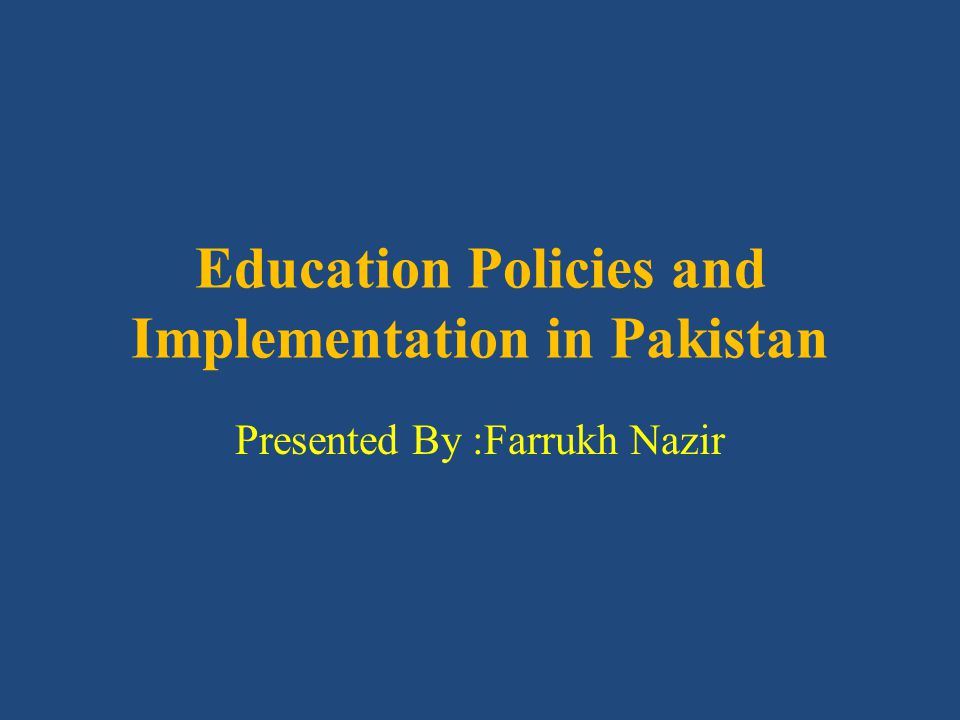
Foundations of American Education, Fifth Edition

1 (c) 2008 The McGraw Hill Companies Redesigning Teacher Salary Structures School Finance: A Policy Perspective, 4e Chapter 12.

[Imagine School at North Port] Oral Exit Report Quality Assurance Review Team School Accreditation.

THE 2004 LIVING CONDITIONS MONITORING SURVEY : ZAMBIA EXTENT TO WHICH GENDER WAS INCORPORATED presented at the Global Forum on Gender Statistics, Accra.

1 POLICY ON SCIENCE AND TECHNOLOGY BY: M.B. WILLIAMS DIRECTOR, DEPARTMENT OF SCIENCE AND TECHNOLOGY.

Building Our Future: One Community, One School, One Child at a Time Goals of the Special Administrative Board St. Louis Public Schools October 14, 2008.

Prof. V.J. Papazoglou on behalf of the Hellenic Quality Assurance Agency for Higher Education (HQAA) ENQA Seminar on Current Trends in the European Quality.

1. 2 Why are Result & Impact Indicators Needed? To better understand the positive/negative results of EC aid. The main questions are: 1.What change is.

Pacific Regional Digital Strategy II Suella Hansen & Noelle Jones Presentation for APT 28 April 2010.

Council for Education Policy, Research and Improvement CEPRI Projects Presentation to State Board of Education February 17, 2004.

Core Pre-K Standards Review & Comment

1 Career Pathways for All Students PreK-14 2 Compiled by Sue Updegraff Keystone AEA Information from –Iowa Career Pathways –Iowa School-to-Work –Iowa.

UCET Annual Conference 2011 Shifting Sands and Stable Foundations: Insecurity and Instability in Teacher Education.

Managing the Statutory Requirements for Assessment April 2011.

Marcela santillán Tenoch Cedillo

THE UNIQUENESS IN SCHOOL EDUCATION PRESENTED BY DIRECTORATE OF EDUCATION Government of Goa.

18th amendment to constitution of pakistan

Subchapter M-Indian Self- Determination and Education Assistance Act Program Part 273-Education Contracts under Johnson-OMalley Act.

1 India Education For All Overview of Progress and Challenges E-9 Ministerial Meeting 8-10, November 2012 New Delhi, India.

EAC HIGHER EDUCATION POLICY
About project
© 2024 SlidePlayer.com Inc. All rights reserved.
Bestiality references allegedly made during presentation at Renmark High School
Warning for readers: This article contains graphic language.
The South Australian Department for Education is investigating a presentation delivered to year 9 girls in a regional high school that allegedly referenced bestiality as being accepted by the LGBTQIA+ community.
Female students said teachers at Renmark High School told them to leave their lessons and attend a presentation in a separate classroom.
Students who attended the presentation on March 22 say two staff from the Headspace centre in the neighbouring town of Berri introduced a "third-party" presenter who facilitated an hour-long presentation focused on relationships.
Parents said they were not notified about the presentation, nor was it consented to.
Students said they were left unsupervised for the duration of the presentation.
Student Courtney White, 14, said she felt confused and blindsided by the presentation.
"We had a teacher that told us to grab a chair and sit in front of the board, and then the Headspace people came in and then [the teacher] left, so then we're sitting in front of a board alone with no teachers, just the Headspace people," she said.
"The first slide of the PowerPoint on the board was 'You can see queerly now' and 'No point hiding.'"
Girls felt 'really uncomfortable'
Fourteen-year-old Emelia Wundenberg said the presenter was graphic when referencing their own sexual preferences and spoke in sexually explicit terms about growing up and being confused about whether they idolised people of the same gender or wanted to be intimate with them.
Students say they were then given an explanation of the initialism LGBTQIA+, with each word and its meaning displayed on the screen.
"There was a slide for what the 'plus' means, and they just started randomly saying words that no-one knew, like bestiality," Emelia said.
"It was on the board when they were showing what the 'plus' meant."
The students said bestiality was then explained in detail and the presenter seemed to imply it was something practised by people who identified as LGBTQIA+.
"They said [the queer community] just accepts all of it, even though … isn't it illegal?" Emelia said.
As the talk went on multiple girls, including Courtney, began to feel uncomfortable and asked to leave the classroom to "go to the bathroom".
"We're all just sitting there like, 'What the hell? What are we doing here? Why are we learning about animals having sex with humans?'" she said.
"It was really disgusting, it was really uncomfortable."
Emelia said many of those who asked to leave the classroom did not return.
When the ABC sought comment from the presenter a response was sent on the person's behalf asking that reporters refrained from reaching out or naming them in its coverage.
'Normal procedure' not followed
Letters seen by the ABC that were sent to parents on behalf of Renmark High School principal Mat Evans stated that the presentation was meant to discuss "respectful relationships".
The letter acknowledged that the school's "normal procedure for notifying parents ahead of specific presentations was not followed".
Mr Evans said the third-party presenter had "been suspended from department schools while the department undertakes an investigation".
"We are undertaking an internal review to ensure that processes around such notifications and procedures with regard to third parties attending at our school are always met," he said.
The ABC contacted the Department for Education, which provided a similar statement and said the presentation was being investigated.
SA education department chief executive Martin Westwell said the presentation was "unacceptable" and "shouldn't have happened".
Speaking with ABC Radio Adelaide on Thursday, Professor Westwell said conversations about sexual health, societal norms, stereotypes and sexuality were normal parts of the Australian curriculum, but the presentation at Renmark High School was not.
"The core idea that students should understand sexuality and other sexualities is, I think, really important — but the way [the presenter] went about it was unacceptable," he said.
"The school has clearly made some mistakes.
"There should have been a teacher in the room when that occurred, but there wasn't and the principal has apologised for that.
"They hadn't reviewed the content.
"There was a few things that went wrong and it ended up with this inappropriate language and a few things being discussed in that session that were just not appropriate."
Support being provided to students
Headspace's national head of clinical leadership Nicola Palfrey said the organisation was aware of concerns raised by members of the Renmark community.
"We take all feedback very seriously and are reviewing how we can support and guide Headspace centres … to ensure presentations they facilitate or deliver are aligned with evidence and best practice and are safe and appropriate for young people," she said.
FocusOne Health Board chair Ian Gartley said the "focus at Headspace Berri, operated under licence by FocusOne Health, is on the mental health and wellbeing of young people".
"We are aware of concerns raised by local members of the Renmark community following a presentation delivered by a lived experience speaker that Headspace Berri facilitated at Renmark High School," he said.
"Our priority right now is ensuring that any young people and their families who may be experiencing distress receive the support they need."
All parties involved in the alleged incident declined to provide the presentation to the ABC.
Following the presentation, a follow-up letter seen by the ABC was sent to parents offering counselling services from the education department, which had arranged a social worker to attend the school to help support affected students.
Parents express shock and outrage
Parents of students who attended the presentation said it was a poor representation of the queer community and had raised many concerns about the school's protocols for third-party presentations.
"Who vetted this material? Who made sure it was safe for 14- and 15-year-old girls? Some of them are still 13," Emelia's mother Kristy Fyfe said.
"It has done a huge disservice to the [queer] community."
Following the presentation, Courtney's mother Nicki Gaylard removed her three children from Renmark High School.
"My kids are in limbo," she said.
"They're not in an education department at this point.
"I'm not putting them anywhere until I know this won't happen again.
"Under no circumstances should a child in that school ever feel trapped and unsafe without someone with their certificate, meaning a teacher."
The ABC has spoken to five other parents whose children attended the presentation.
They substantiated the two girls' claims.
LGBTQIA+ educators condemn 'slur'
Sexuality educators and LGBTQIA+ inclusion advocates Mel Brush and Eleonora Bertsa-Fuchs conduct consent and queer inclusion training for schools, parents and workplaces via their social enterprise Let's Talk About X.
Both are secondary teachers and Mx Bertsa-Fuchs said queer education was important but should be delivered in a safe and appropriate setting.
"The teachers are the people that these young people have a relationship with, that they are familiar with, that they're comfortable with," Mx Bertsa-Fuchs said.
"When you're in a vulnerable situation, like a respectful relationships workshop or seminar, there should be someone in the room that you are familiar with."
Mx Brush said the alleged use of the word bestiality in the presentation was damaging to the queer community.
"It's pretty shocking to think about that term being thrown around like that, especially given how loaded it is, and for a historical context of the way that it's been used as a slur and to discriminate against LGBT+ people," Mx Brush said.
ABC Riverland — local news in your inbox
- X (formerly Twitter)
- Relationships
- Renmark South
- Safety Education
- Secondary Schools

IMAGES
VIDEO
COMMENTS
Education Policies and Implementation in Pakistan Presented By :Farrukh Nazir. Education policy • Education policy is the principles and government policy-making in educational sphere, as well as the collection of laws and rules that govern the operation of education systems.(wikipedia2013). • Education occurs in many forms for many purposes through many institutions.
Education in Pakistan is overseen by the Federal Ministry of Education and the provincial governments, while the federal government mostly assists in curriculum development, accreditation and the financing of research and development.Article 25-A of the Constitution of Pakistan obligates the state to provide free and compulsory quality education to children of the age group 5 to 16 years.
While enrollment and retention rates are improving, progress has been slow to improve education indicators in Pakistan. An estimated 22.8 million children aged 5-16 are out-of-school. Currently, Pakistan has the world's second-highest number of out-of-school children (OOSC) with an estimated 22.8 million children aged 5-16 not attending ...
Education For All (EFA) and Millennium Development Goals (MDGs) by the UN's Sustainable Development Goals (SDGs) that have been adopted by Pakistan also as its own Agenda for Development. Besides, after 18th amendment implementation of National Education Policy 2009 was virtually stopped as per findings of National Education Policy
This case has two parts, a text-based case and a supplemental PowerPoint presentation. The case traces the evolution of an evidence-based research study on the education sector in Pakistan. In 2003, Atish (fictionalized character), a Pakistan-born, Harvard educated economist returns to his native Pakistan to help reform a lagging education system. But Atish unearths conflicting information on ...
Pakistan's education sector faces critical challenges, which are believed to have been deepened by COVID-19 and the 2022 Floods. These catastrophes have only added to the world's second-highest population of out-of-school children, which was at 20.3 million before them. Even before the pandemic, Pakistan had 75% Learning Poverty, which ...
1 Literacy Rates across Pakistan, 2014-2015 2 2 Education Governance Structure in Pakistan 7 3 Proportion of Education Institutions in Pakistan, by Level and Type, 2016-2017 9 4 Number of Out-of-School Children in Pakistan, 2016-2017 10 5 Net Enrollment Rates at Primary, Middle, and High School Levels 12
Getting girls to school is a priority in Pakistan, which has the second largest out-of-school population of any country. Nearly 23 million Pakistani children aged 5 to 16 do not attend school. Aside from teacher shortages, distance to school and safety are the largest barriers to accessing education in rural areas, with 29 percent of parents ...
Aims of Education in Pakistan - Free download as Powerpoint Presentation (.ppt / .pptx), PDF File (.pdf), Text File (.txt) or view presentation slides online. presentation about aims of education in pakistan according to educational policy 1998-2010
1 Ethics and Education in Pakistan: Principles. Ethics is a code of conduct, that an individual, group or society holds as definitive stand in differentiating right and wrong (Saulat 2014 ); while, education is considered central to the moral fulfillment of individuals and the well-being of the society in which they live (OECD 2013 ).
However, the reality is vastly different. The literacy rate in Pakistan in 2021 was only 62.8%. Any gains in literacy rates over the last many years have been small, slow and marginal. In 2021-22, we spent only 1.77% of GDP on education-related expenditure at both the federal and provincial levels.
52 THANK YOU. Download ppt "Education Policies and Implementation in Pakistan". Education policy Education policy is the principles and government policy-making in educational sphere, as well as the collection of laws and rules that govern the operation of education systems. (wikipedia2013).
Education Policy and Implementation in Pakistan - Free download as Powerpoint Presentation (.ppt / .pptx), PDF File (.pdf), Text File (.txt) or view presentation slides online. "You know that the importance of education and the right type of education cannot be over emphasized under foreign rule over a country, in the very nature of things I regret sufficient attention has not been paid to ...
In October 2012, 14 year old school girl Malala Yousafzai was shot and seriously injured by Taliban militants in north-west Pakistan. Malala was targeted for campaigning for girls' right to education. "Even if they come to kill me, I will tell them what they are trying to do is wrong, that education is our basic right.".
secondary education in pakistan - Free download as Powerpoint Presentation (.ppt / .pptx), PDF File (.pdf), Text File (.txt) or view presentation slides online.
The South Australian Department for Education is investigating a presentation delivered to year 9 girls in a regional high school that allegedly referenced bestiality as being accepted by the ...